-
 Ovid's Art of Love. In Three Books. Together with His Remedy of Love. Translated Into English Verse By Dryden, Congreve, and Others. To Which are Added The Court of Love, a Tale, from Chaucer and the History of Love, Ovid, Maynwaring, Hopkins, translated by Dryden & Congreve (Printed for Jacob & Richard Tonson, London, 1764) 4″x6.75″, 7+265pp, gilt edges, beautiful decorative full red Moroccan leather binding by master binder Canape, 5 raised bands, gilt titles and decorations including boarder of paste-down, marbled boards, very good condition for age, frontispieces for each work, engraver unknown. This book contains an English translation of Ovid’s Book of Love and two works in the style of Ovid: Chaucer’s The Court, by Arthur Maynwaring, and the History of Love by Charles Hopkins. The Art of Love (Ars amatorial) is an instructional elegy series written in 2 AD in three books by the ancient Roman poet Ovid. Book 1 shows a man how to find a woman. In book two, Ovid shows how to keep her. The third book, written two years after the first books were published, Ovid gives women advice on how to win and keep the love of a man. Arthur Maynwaring (1668-1712) of Ightfield, Shropshire, was an English official and Whig politician who sat in the English and British House of Commons from 1706 to 1712. He was also a journalist and a polemic political author. In this work he paraphrases Chaucer’s The Court of Love using the poetic style of Ovid. Charles Hopkins (1664?–1700?) was an Anglo-Irish poet and dramatist. The elder son of Ezekiel Hopkins, bishop of Derry, he was born about 1664 at Exeter and was taken early to Ireland. He was educated at Trinity College, Dublin, and then at Queens' College, Cambridge, where he graduated B.A. 1688. Returning to Ireland Hopkins engaged in military service. He subsequently settled in England, and gained some reputation as a writer of poems and plays. Giles Jacob in the Poetical Register says that he might have made a fortune in any scene of life, but was unmotivated. His death aged 35, about the beginning of 1700, was put down to a “debauched lifestyle”. The full title to his contribution to this work is History of Love. A poem in a letter to a lady. The letter is addressed to “Her Grace the Dutchess of Grafton” who was Isabella Bennet FitzRoy (1668 -1723). It was originally published in 1695. Considered one of France’s master binders, Georges Canape, Georges (1864-1940) is the son of the bookbinder Pierre Jules Canape established in rue du Bac. He inherited his father's workshop in 1894 and also became a gilder. Canape follows the Art Nouveau movement of its time. Around 1927, he joined forces with the bookbinder Corriez.
Ovid's Art of Love. In Three Books. Together with His Remedy of Love. Translated Into English Verse By Dryden, Congreve, and Others. To Which are Added The Court of Love, a Tale, from Chaucer and the History of Love, Ovid, Maynwaring, Hopkins, translated by Dryden & Congreve (Printed for Jacob & Richard Tonson, London, 1764) 4″x6.75″, 7+265pp, gilt edges, beautiful decorative full red Moroccan leather binding by master binder Canape, 5 raised bands, gilt titles and decorations including boarder of paste-down, marbled boards, very good condition for age, frontispieces for each work, engraver unknown. This book contains an English translation of Ovid’s Book of Love and two works in the style of Ovid: Chaucer’s The Court, by Arthur Maynwaring, and the History of Love by Charles Hopkins. The Art of Love (Ars amatorial) is an instructional elegy series written in 2 AD in three books by the ancient Roman poet Ovid. Book 1 shows a man how to find a woman. In book two, Ovid shows how to keep her. The third book, written two years after the first books were published, Ovid gives women advice on how to win and keep the love of a man. Arthur Maynwaring (1668-1712) of Ightfield, Shropshire, was an English official and Whig politician who sat in the English and British House of Commons from 1706 to 1712. He was also a journalist and a polemic political author. In this work he paraphrases Chaucer’s The Court of Love using the poetic style of Ovid. Charles Hopkins (1664?–1700?) was an Anglo-Irish poet and dramatist. The elder son of Ezekiel Hopkins, bishop of Derry, he was born about 1664 at Exeter and was taken early to Ireland. He was educated at Trinity College, Dublin, and then at Queens' College, Cambridge, where he graduated B.A. 1688. Returning to Ireland Hopkins engaged in military service. He subsequently settled in England, and gained some reputation as a writer of poems and plays. Giles Jacob in the Poetical Register says that he might have made a fortune in any scene of life, but was unmotivated. His death aged 35, about the beginning of 1700, was put down to a “debauched lifestyle”. The full title to his contribution to this work is History of Love. A poem in a letter to a lady. The letter is addressed to “Her Grace the Dutchess of Grafton” who was Isabella Bennet FitzRoy (1668 -1723). It was originally published in 1695. Considered one of France’s master binders, Georges Canape, Georges (1864-1940) is the son of the bookbinder Pierre Jules Canape established in rue du Bac. He inherited his father's workshop in 1894 and also became a gilder. Canape follows the Art Nouveau movement of its time. Around 1927, he joined forces with the bookbinder Corriez. -
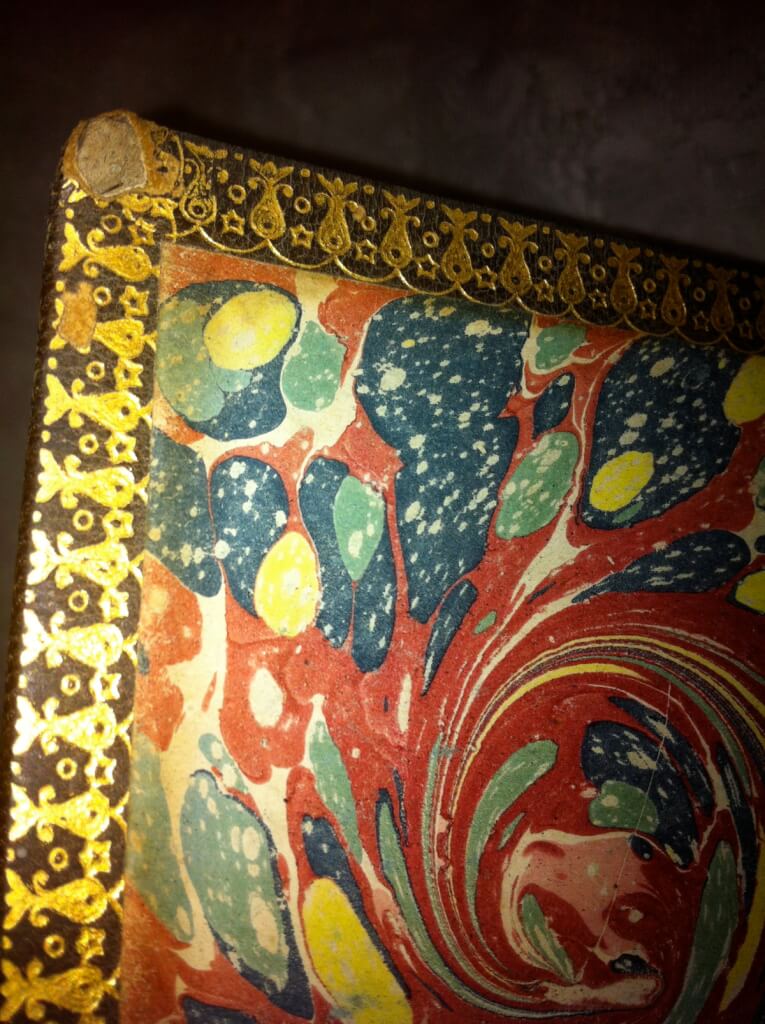
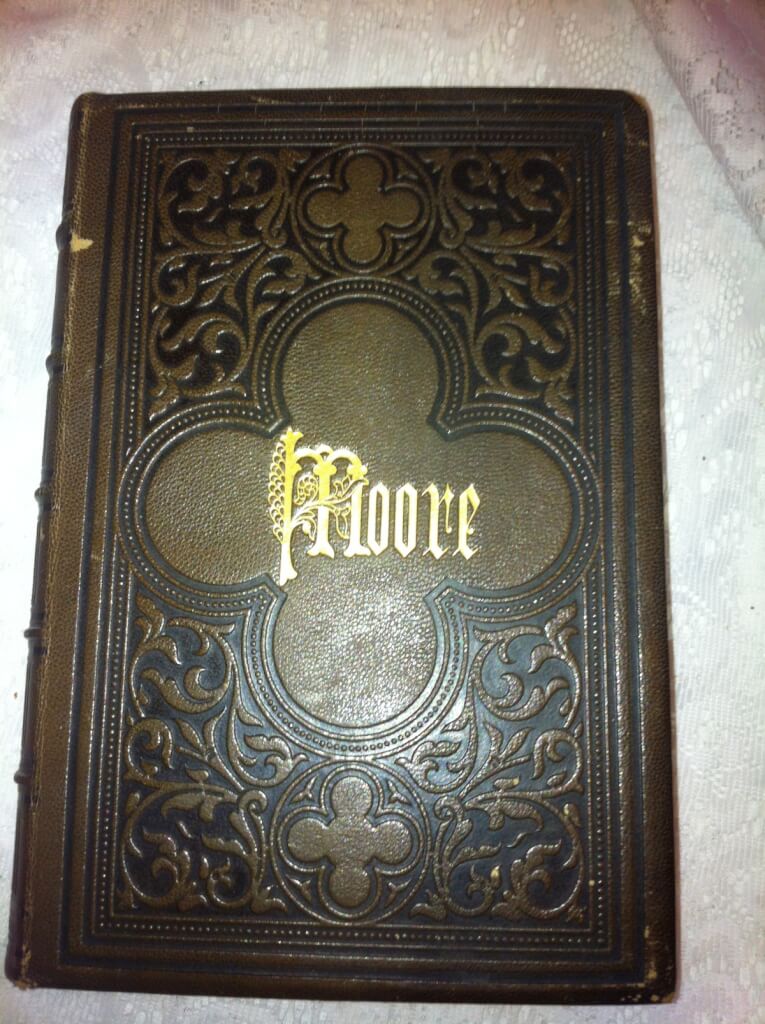 The Poetical Works of Thomas Moore, Thomas Moore (Oliver S. Felt, New York, nd. [c.1860]) 9.5" X 6.5", 776pp., 8 volumes in one. Full leather binding, tooled leather, gilt lettering and decorations, 5 raised bands on spine, marbled end papers, gilt edges. Beautiful steel engravings throughout with tissue guards. Thomas Moore (1779 _ 1852) is considered Ireland's "National Bard". He was a poet, singer, songwriter, and entertainer. He was responsible, with John Murray, for burning Lord Byron's memoirs after his death.
The Poetical Works of Thomas Moore, Thomas Moore (Oliver S. Felt, New York, nd. [c.1860]) 9.5" X 6.5", 776pp., 8 volumes in one. Full leather binding, tooled leather, gilt lettering and decorations, 5 raised bands on spine, marbled end papers, gilt edges. Beautiful steel engravings throughout with tissue guards. Thomas Moore (1779 _ 1852) is considered Ireland's "National Bard". He was a poet, singer, songwriter, and entertainer. He was responsible, with John Murray, for burning Lord Byron's memoirs after his death. -
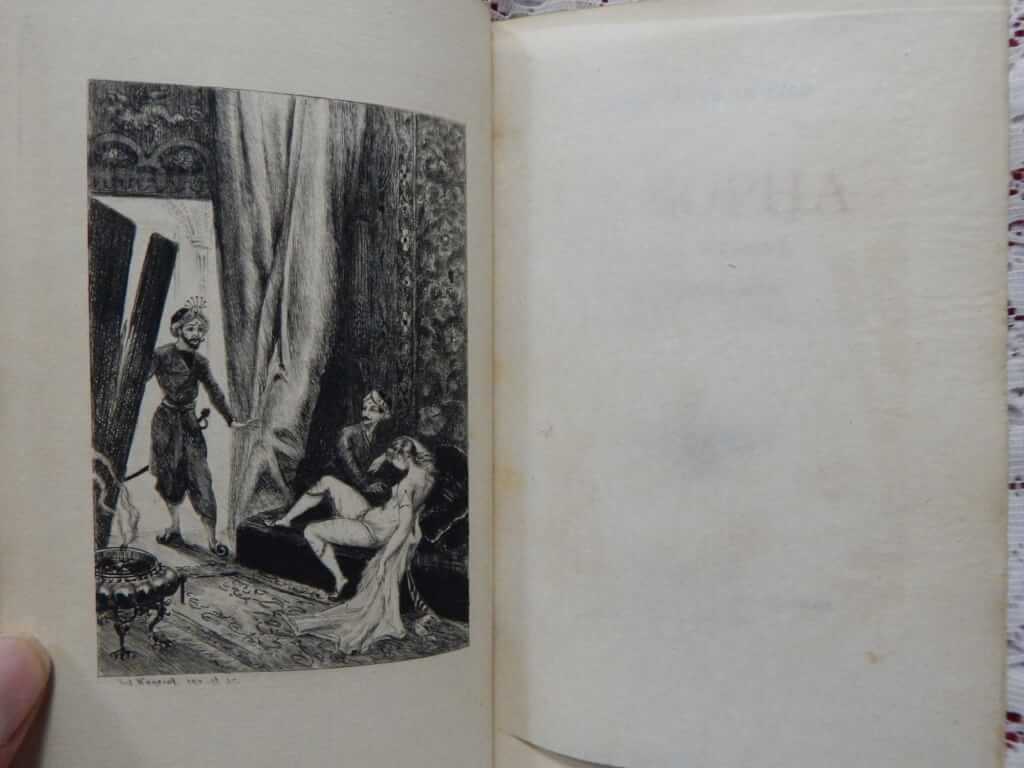
 Le Sopha, conte moral by Crébillon fils, illus. Hanriot (Ch. Gilliet, Bruxelles, 1881, #380/550, Imprimerie Clerbaut & Cie.) 5"x7.5", 342pp, 3/4 morocco over marbled boards, 5 raised bands, gilt titles on spine (title worn), marbled endpapers, top-edge gilt, other edges deckled, printed on hand-laid "papier de Hollande", green ribbon intact, frontispiece with tissue guard and 2 small engravings by Hanriot, beautifully bound copy in very good+ condition with delicate engravings Le Sopha, conte moral is a 1742 libertine novel by Claude Prosper Jolyot de Crébillon (Crebillon fils). It was first translated into English in the spring of 1742. The story concerns a young courtier, Amanzéï, whose soul in a previous life was condemned by Brahma to inhabit a series of sofas, and not to be reincarnated in a human body until two virgin lovers had consummated their passion for him. The novel is structured as a frame story in an oriental setting, explicitly evocative of the Arabian Nights, in which Amanzéï recounts the adventures of seven couples, which he witnessed in his sofa form, to the bored sultan Shah Baham (grandson of Shehryār and Scheherazade). The longest episode, that of Zulica, takes up nine chapters; the final episode concerns the teenage Zéïnis et Phéléas. Amanzéï, witnessing their innocent pleasure, is edified and freed through the experience of virtuous love. Many of the characters in the novel are satirical portraits of influential and powerful Parisians of Crébillon’s time; the author takes the opportunity to ridicule hypocrisy in its different forms (worldly respectability, virtue, religious devotion). Claude Prosper Jolyot de Crébillon (1707-1777) was a French novelist. He was called "Crébillon fils" to distinguish him from his father, a famous tragedian, Prosper Jolyot de Crébillon. The publication of Tanzaï et Neadarne, histoire japonaise (1734), which contained thinly veiled attacks on the Papal bull Unigenitus, the cardinal de Rohan and others, landed him briefly in the prison at Vincennes. Although Le Sopha was published anonymously and with a false imprint, Crébillon was discovered to be the author and was exiled to a distance of thirty leagues from Paris on April 7, 1742. He was able to return on July 22, after claiming that the work had been commissioned by Frederick II of Prussia and that it had been published against his will. Jules-Armand Hanriot (1853-1930) was a French painter, engraver and illustrator.
Le Sopha, conte moral by Crébillon fils, illus. Hanriot (Ch. Gilliet, Bruxelles, 1881, #380/550, Imprimerie Clerbaut & Cie.) 5"x7.5", 342pp, 3/4 morocco over marbled boards, 5 raised bands, gilt titles on spine (title worn), marbled endpapers, top-edge gilt, other edges deckled, printed on hand-laid "papier de Hollande", green ribbon intact, frontispiece with tissue guard and 2 small engravings by Hanriot, beautifully bound copy in very good+ condition with delicate engravings Le Sopha, conte moral is a 1742 libertine novel by Claude Prosper Jolyot de Crébillon (Crebillon fils). It was first translated into English in the spring of 1742. The story concerns a young courtier, Amanzéï, whose soul in a previous life was condemned by Brahma to inhabit a series of sofas, and not to be reincarnated in a human body until two virgin lovers had consummated their passion for him. The novel is structured as a frame story in an oriental setting, explicitly evocative of the Arabian Nights, in which Amanzéï recounts the adventures of seven couples, which he witnessed in his sofa form, to the bored sultan Shah Baham (grandson of Shehryār and Scheherazade). The longest episode, that of Zulica, takes up nine chapters; the final episode concerns the teenage Zéïnis et Phéléas. Amanzéï, witnessing their innocent pleasure, is edified and freed through the experience of virtuous love. Many of the characters in the novel are satirical portraits of influential and powerful Parisians of Crébillon’s time; the author takes the opportunity to ridicule hypocrisy in its different forms (worldly respectability, virtue, religious devotion). Claude Prosper Jolyot de Crébillon (1707-1777) was a French novelist. He was called "Crébillon fils" to distinguish him from his father, a famous tragedian, Prosper Jolyot de Crébillon. The publication of Tanzaï et Neadarne, histoire japonaise (1734), which contained thinly veiled attacks on the Papal bull Unigenitus, the cardinal de Rohan and others, landed him briefly in the prison at Vincennes. Although Le Sopha was published anonymously and with a false imprint, Crébillon was discovered to be the author and was exiled to a distance of thirty leagues from Paris on April 7, 1742. He was able to return on July 22, after claiming that the work had been commissioned by Frederick II of Prussia and that it had been published against his will. Jules-Armand Hanriot (1853-1930) was a French painter, engraver and illustrator. -
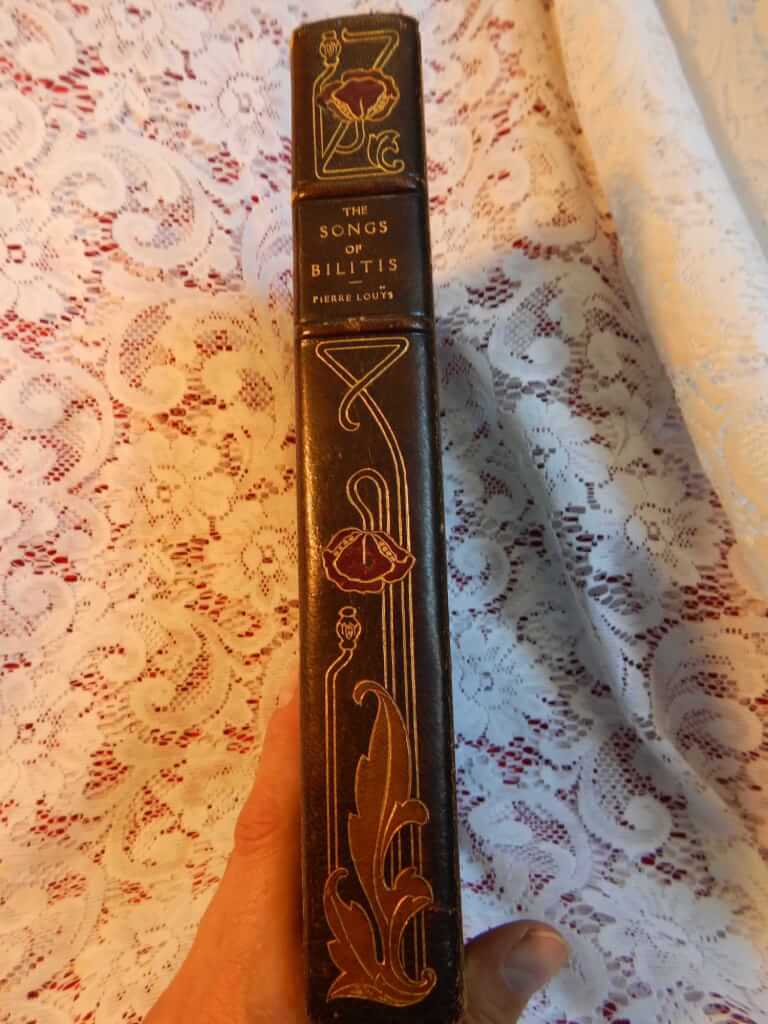
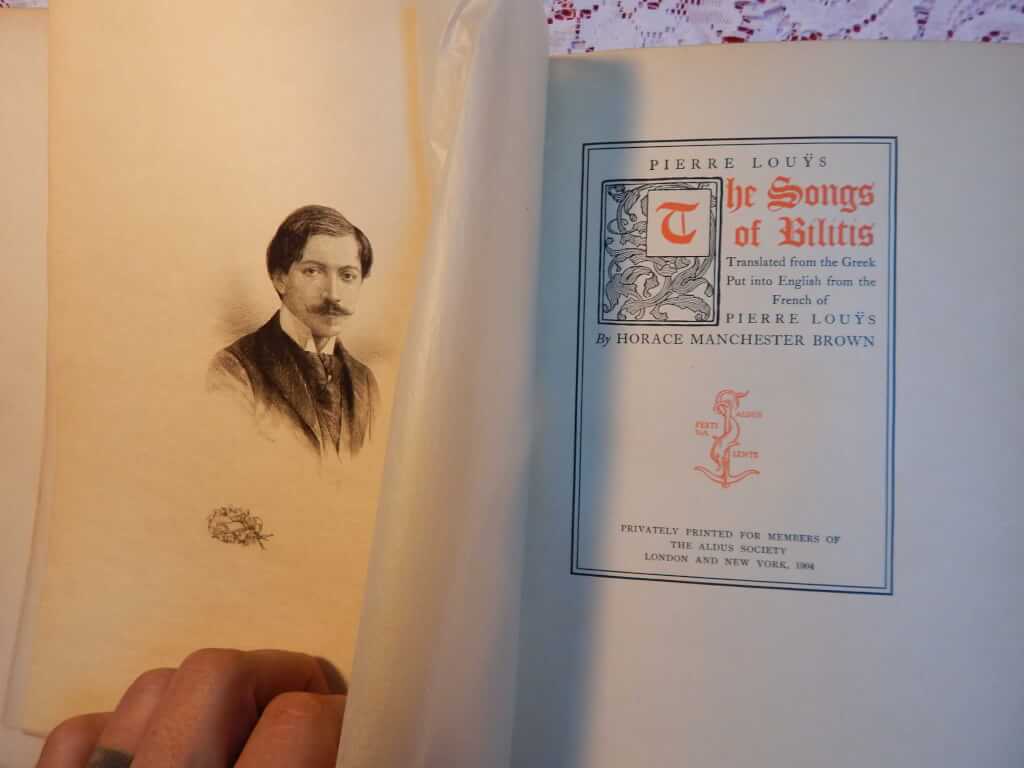 The Songs of Bilitis, Translated from the Greek, Put into English from the French of Pierre Louys by Horace Manchester Brown, illust. James Fagan (Privately Printed for Members of the Aldus Society, London and New York, 1904, #30/971) 7.25"x10.25", 341pp., 3/4 blue leather over blue boards, gilt decorations on boards, gilt titles and gilt and color decorations on spine, marbled boards, top edge gilt, other edges deckled, frontispiece portrait of author and two original etchings by James Fagan, good+ condition for age, some rubbing on spine and bumping to corners. Early (first?) translation of Les Chansons de Bilitis, rare and beautifully bound english translation of this classic in lesbian literature. The Songs of Bilitis (Les Chansons de Bilitis) is a collection of erotic, essentially lesbian, poetry by Pierre Louÿs published in Paris in 1894. Since Louÿs claimed that he had translated the original poetry from Ancient Greek, this work is considered a pseudotranslation. The poems are in the manner of Sappho; the collection's introduction claims they were found on the walls of a tomb in Cyprus, written by a woman of Ancient Greece called Bilitis, a courtesan and contemporary of Sappho to whose life Louÿs dedicated a small section of the book. On publication, the volume deceived even the most expert of scholars. Louÿs claimed the 143 prose poems, excluding 3 epitaphs, were entirely the work of this ancient poet — a place where she poured both her most intimate thoughts and most public actions, from childhood innocence in Pamphylia to the loneliness and chagrin of her later years. Although for the most part The Songs of Bilitis is original work, many of the poems were reworked epigrams from the Palatine Anthology, and Louÿs even borrowed some verses from Sappho herself. The poems are a blend of mellow sensuality and polished style in the manner of the Parnassian school, but underneath run subtle Gallic undertones that Louÿs could never escape. To lend authenticity to the forgery, Louÿs in the index listed some poems as "untranslated"; he even craftily fabricated an entire section of his book called "The Life of Bilitis", crediting a certain fictional archaeologist Herr G. Heim ("Mr. C. Cret" in German) as the discoverer of Bilitis' tomb. And though Louÿs displayed great knowledge of Ancient Greek culture, ranging from children's games in "Tortie Tortue" to application of scents in "Perfumes", the literary fraud was eventually exposed. This did little, however, to taint their literary value in readers' eyes, and Louÿs' open and sympathetic celebration of lesbian sexuality earned him sensation and historic significance.
The Songs of Bilitis, Translated from the Greek, Put into English from the French of Pierre Louys by Horace Manchester Brown, illust. James Fagan (Privately Printed for Members of the Aldus Society, London and New York, 1904, #30/971) 7.25"x10.25", 341pp., 3/4 blue leather over blue boards, gilt decorations on boards, gilt titles and gilt and color decorations on spine, marbled boards, top edge gilt, other edges deckled, frontispiece portrait of author and two original etchings by James Fagan, good+ condition for age, some rubbing on spine and bumping to corners. Early (first?) translation of Les Chansons de Bilitis, rare and beautifully bound english translation of this classic in lesbian literature. The Songs of Bilitis (Les Chansons de Bilitis) is a collection of erotic, essentially lesbian, poetry by Pierre Louÿs published in Paris in 1894. Since Louÿs claimed that he had translated the original poetry from Ancient Greek, this work is considered a pseudotranslation. The poems are in the manner of Sappho; the collection's introduction claims they were found on the walls of a tomb in Cyprus, written by a woman of Ancient Greece called Bilitis, a courtesan and contemporary of Sappho to whose life Louÿs dedicated a small section of the book. On publication, the volume deceived even the most expert of scholars. Louÿs claimed the 143 prose poems, excluding 3 epitaphs, were entirely the work of this ancient poet — a place where she poured both her most intimate thoughts and most public actions, from childhood innocence in Pamphylia to the loneliness and chagrin of her later years. Although for the most part The Songs of Bilitis is original work, many of the poems were reworked epigrams from the Palatine Anthology, and Louÿs even borrowed some verses from Sappho herself. The poems are a blend of mellow sensuality and polished style in the manner of the Parnassian school, but underneath run subtle Gallic undertones that Louÿs could never escape. To lend authenticity to the forgery, Louÿs in the index listed some poems as "untranslated"; he even craftily fabricated an entire section of his book called "The Life of Bilitis", crediting a certain fictional archaeologist Herr G. Heim ("Mr. C. Cret" in German) as the discoverer of Bilitis' tomb. And though Louÿs displayed great knowledge of Ancient Greek culture, ranging from children's games in "Tortie Tortue" to application of scents in "Perfumes", the literary fraud was eventually exposed. This did little, however, to taint their literary value in readers' eyes, and Louÿs' open and sympathetic celebration of lesbian sexuality earned him sensation and historic significance. -

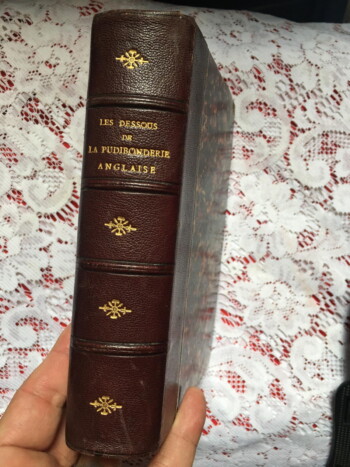 Les dessous de la pudibonderie anglaise expliqués dans les divorces anglais, ou procès en adultère jugés par le banc du Roi et la Cour Ecclésiastique d'Angleterre [trans. The Basics of English Prudishness Explained in English Divorces, or Adultery Trial Judged by the King's Bench and the Ecclesiastical Court of England], anonymous [most like Carrington himself as editor/compiler], illustrations Jacques Wely (Charles Carrington, Paris, 1898, first edition) 7.5"x5", 2 volumes in one, xxiv-108, xxx-287-xii, quarter morocco over marbled boards, 4 raised bands, gilt titles and decoration on spine, marbled endpapers, great condition, previous owners name on title page, some bumping to corners. According to the British Library this is a compilation of entries from "Trials for Adultry" [Trials for Adultery: or, the History of Divorces. Being Select Trials at Doctors Commons, for Adultery, Cruelty, Fornication, Impotence, &c. From the Year 1760, to the present Time. Including the whole of the Evidence on each Cause. Together with The Letters, &c. that have been intercepted between the amorous Parties… Taken in Short-Hand , by a Civilian. London: Printed for S. Bladon, 1779-1780] which, as the full title suggests, is considered one of the Earliest of "The Genre of Pornographic Trial Reports". Also present are excerpts from some English plays. According to Yale, this compillation also "Contains case histories from: Crim. con. biography attributed to Francis Plowden." London, 1798. Criminal conversation, commonly known as crim. con., is a tort arising from adultery, abolished in almost all jurisdictions. (Conversation is an old expression for sexual intercourse that is obsolete except as part of this term.) As far as we can tell, this is a book compiled and edited by Carrington. Carrington himself was an Englishman, a Londoner who was married to a woman from France. He published this book a few years after the couple left London and moved to Paris, presumably so he would have more freedom to publish books that London would have no doubt considered pornography. This book is a case study of the prudishness of the English and it uses salacious material taken from various sources listed above to prove the point.
Les dessous de la pudibonderie anglaise expliqués dans les divorces anglais, ou procès en adultère jugés par le banc du Roi et la Cour Ecclésiastique d'Angleterre [trans. The Basics of English Prudishness Explained in English Divorces, or Adultery Trial Judged by the King's Bench and the Ecclesiastical Court of England], anonymous [most like Carrington himself as editor/compiler], illustrations Jacques Wely (Charles Carrington, Paris, 1898, first edition) 7.5"x5", 2 volumes in one, xxiv-108, xxx-287-xii, quarter morocco over marbled boards, 4 raised bands, gilt titles and decoration on spine, marbled endpapers, great condition, previous owners name on title page, some bumping to corners. According to the British Library this is a compilation of entries from "Trials for Adultry" [Trials for Adultery: or, the History of Divorces. Being Select Trials at Doctors Commons, for Adultery, Cruelty, Fornication, Impotence, &c. From the Year 1760, to the present Time. Including the whole of the Evidence on each Cause. Together with The Letters, &c. that have been intercepted between the amorous Parties… Taken in Short-Hand , by a Civilian. London: Printed for S. Bladon, 1779-1780] which, as the full title suggests, is considered one of the Earliest of "The Genre of Pornographic Trial Reports". Also present are excerpts from some English plays. According to Yale, this compillation also "Contains case histories from: Crim. con. biography attributed to Francis Plowden." London, 1798. Criminal conversation, commonly known as crim. con., is a tort arising from adultery, abolished in almost all jurisdictions. (Conversation is an old expression for sexual intercourse that is obsolete except as part of this term.) As far as we can tell, this is a book compiled and edited by Carrington. Carrington himself was an Englishman, a Londoner who was married to a woman from France. He published this book a few years after the couple left London and moved to Paris, presumably so he would have more freedom to publish books that London would have no doubt considered pornography. This book is a case study of the prudishness of the English and it uses salacious material taken from various sources listed above to prove the point. -

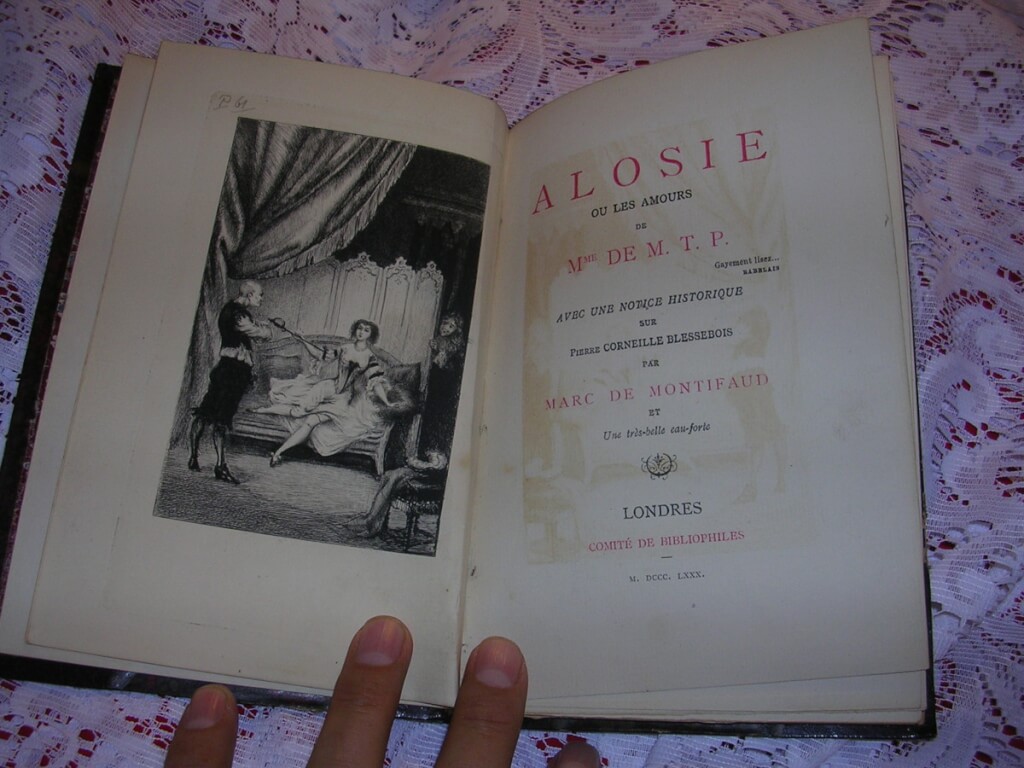 Alosie, ou Les Amours de Mme. de M. T. P. | Avec une notice historique sur Pierre Corneille Blessebois par Marc de Montifaud et Une très-belle eau-forte, Marc de Montifaud [pseud. Marie-Amélie Chartroule, Mme Quivogne de Montifaud] (Comité de Bibliophiles, London, 1880 [131/500 printed on Holland paper]) 7.5" x 5.25", 104pp, hardbound 1/2 leather, marbled boards and endpapers, gilt decorationson spine and leather corners, five raised bands on spine. Top edge gilt. Frontispiece engraving. #131 of 300 on Holland paper. Great condition for age. Initials "P.G." above frontispiece. Mme Quivogne de Montifaud (1845-50 to 1912/13) french writer and "free-thinker". She often dressed as her male pseudonym Marc de Montifaud. This book (published in London in 1880) is a reprint of part of the larger 17th century erotic work, "Amours des dames illustres de nostre siècle" (Loves of Illustrious Ladies of our Century) with an essay where Montifaud tries to unravel the authorship (usually the work is attributed to Pierre Corneille Blessebois). The author changes the original name to reflect that this is an autobiography of Madame de Montespan, the notorius mistress of Louis XIV. When originally published in Holland in 1878 (as "Lupanie, histoire amoureuse de ce temps") a court in Seine called it a moral outrage describing "licentious scenes on almost every page; told in a style revoltingly obscene". For publishing this book Montifaud was sentenced to 8 days in jail and fined 500 francs and ordered all copies of the book destroyed. The publisher was also fined 500 francs. This is a rare copy of a rare book in it's original "publishers leather".
Alosie, ou Les Amours de Mme. de M. T. P. | Avec une notice historique sur Pierre Corneille Blessebois par Marc de Montifaud et Une très-belle eau-forte, Marc de Montifaud [pseud. Marie-Amélie Chartroule, Mme Quivogne de Montifaud] (Comité de Bibliophiles, London, 1880 [131/500 printed on Holland paper]) 7.5" x 5.25", 104pp, hardbound 1/2 leather, marbled boards and endpapers, gilt decorationson spine and leather corners, five raised bands on spine. Top edge gilt. Frontispiece engraving. #131 of 300 on Holland paper. Great condition for age. Initials "P.G." above frontispiece. Mme Quivogne de Montifaud (1845-50 to 1912/13) french writer and "free-thinker". She often dressed as her male pseudonym Marc de Montifaud. This book (published in London in 1880) is a reprint of part of the larger 17th century erotic work, "Amours des dames illustres de nostre siècle" (Loves of Illustrious Ladies of our Century) with an essay where Montifaud tries to unravel the authorship (usually the work is attributed to Pierre Corneille Blessebois). The author changes the original name to reflect that this is an autobiography of Madame de Montespan, the notorius mistress of Louis XIV. When originally published in Holland in 1878 (as "Lupanie, histoire amoureuse de ce temps") a court in Seine called it a moral outrage describing "licentious scenes on almost every page; told in a style revoltingly obscene". For publishing this book Montifaud was sentenced to 8 days in jail and fined 500 francs and ordered all copies of the book destroyed. The publisher was also fined 500 francs. This is a rare copy of a rare book in it's original "publishers leather". -
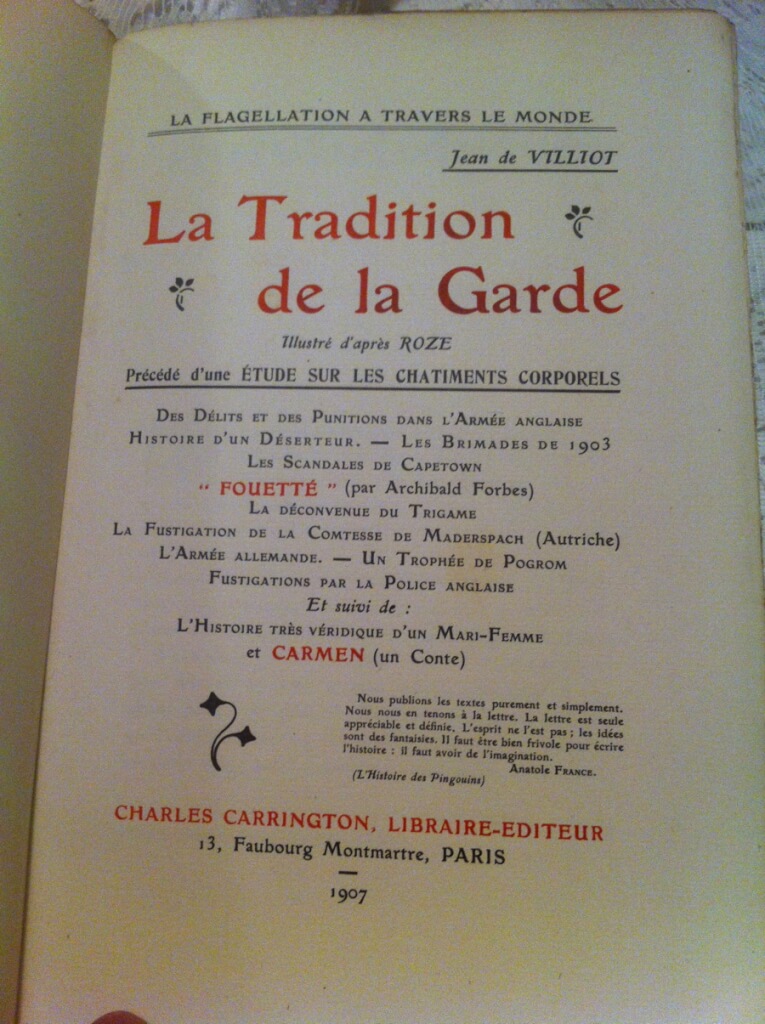
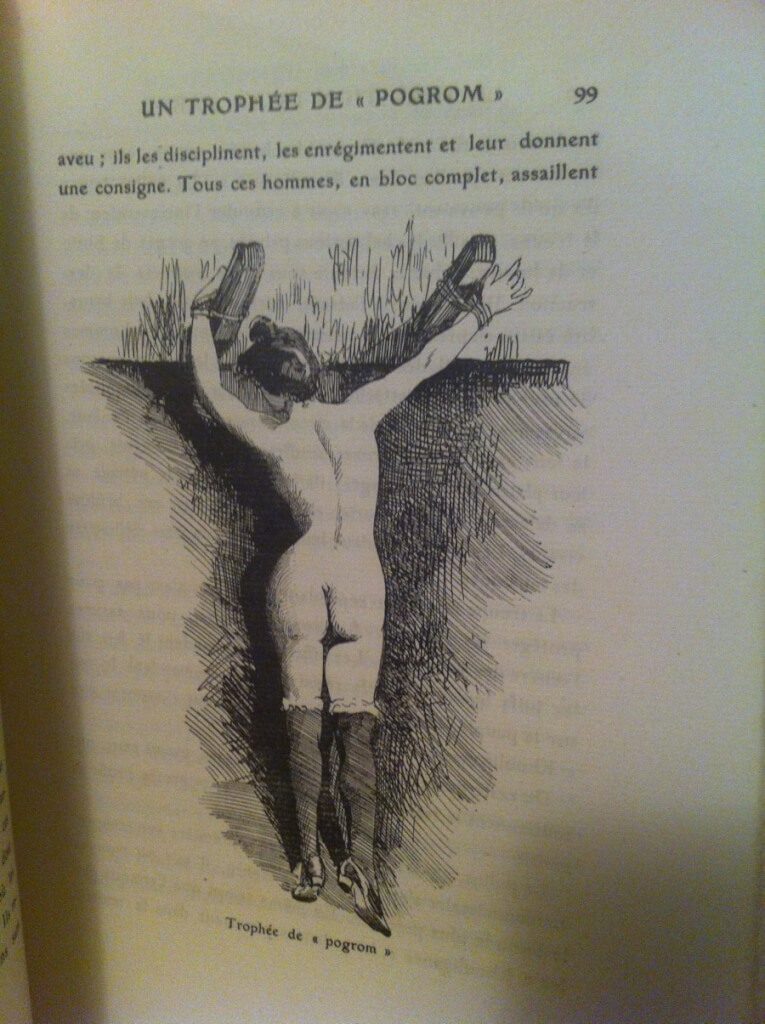 La Tradition de la Garde. Illustré d'après Roze. Précédé d'une étude sur les chatiments corporels. [Tradition of the Guard. Illustrated by Roze. Preceded by a study on corporal punishment.] by Jean de Villiot, [pseud. Georges Grassal de Choffat or Hugues Rebell], illus. Léon Roze (Charles Carrington, Paris, 1907, #244/700) 7.75" x 9.75", 209pp, very good condition for age, some light stains, soft covers and binding good, a rare, numerous illustrations
La Tradition de la Garde. Illustré d'après Roze. Précédé d'une étude sur les chatiments corporels. [Tradition of the Guard. Illustrated by Roze. Preceded by a study on corporal punishment.] by Jean de Villiot, [pseud. Georges Grassal de Choffat or Hugues Rebell], illus. Léon Roze (Charles Carrington, Paris, 1907, #244/700) 7.75" x 9.75", 209pp, very good condition for age, some light stains, soft covers and binding good, a rare, numerous illustrations -

 One Hundred Merrie and Delightsome Stories, ed. by Antoine de La Sale, trans. Robert B. Douglas (Charles Carrington, Paris, 1899 [first edition, first english translation]) 8" X 5.75", xxx 532pp, 3/4 tan morocco leather over marbled boards, gilt title on spine, 5 raised bands, marbled endpapers, excellent condition for age, ribbon intact, small tear at top of front cover. No illustrations One Hundred Merrie And Delightsome Stories (from the original French "Cent Nouvelles nouvelles" France, c. 1456-1461) is a collection of stories supposed to be narrated by various persons at the court of Philippe le Bon, and collected together by Antoine de la Sale in the mid 15th century. Charles Carrington was the first to have this translated into English. This edition does not contain the illustrations which were sold separately.
One Hundred Merrie and Delightsome Stories, ed. by Antoine de La Sale, trans. Robert B. Douglas (Charles Carrington, Paris, 1899 [first edition, first english translation]) 8" X 5.75", xxx 532pp, 3/4 tan morocco leather over marbled boards, gilt title on spine, 5 raised bands, marbled endpapers, excellent condition for age, ribbon intact, small tear at top of front cover. No illustrations One Hundred Merrie And Delightsome Stories (from the original French "Cent Nouvelles nouvelles" France, c. 1456-1461) is a collection of stories supposed to be narrated by various persons at the court of Philippe le Bon, and collected together by Antoine de la Sale in the mid 15th century. Charles Carrington was the first to have this translated into English. This edition does not contain the illustrations which were sold separately. -
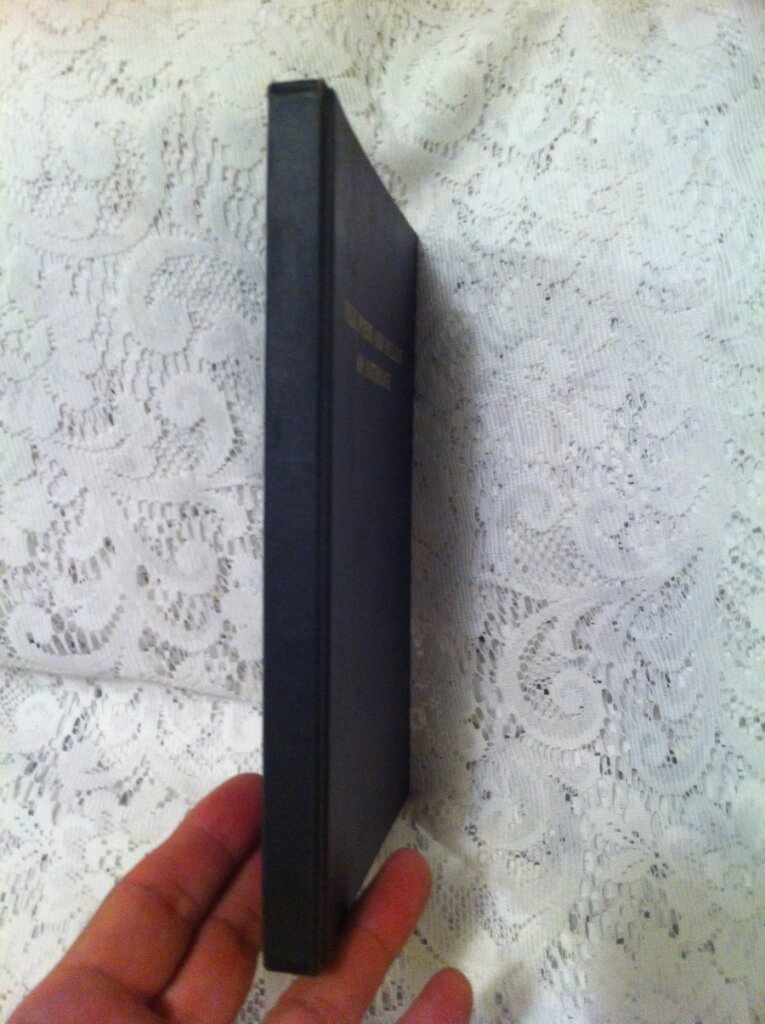
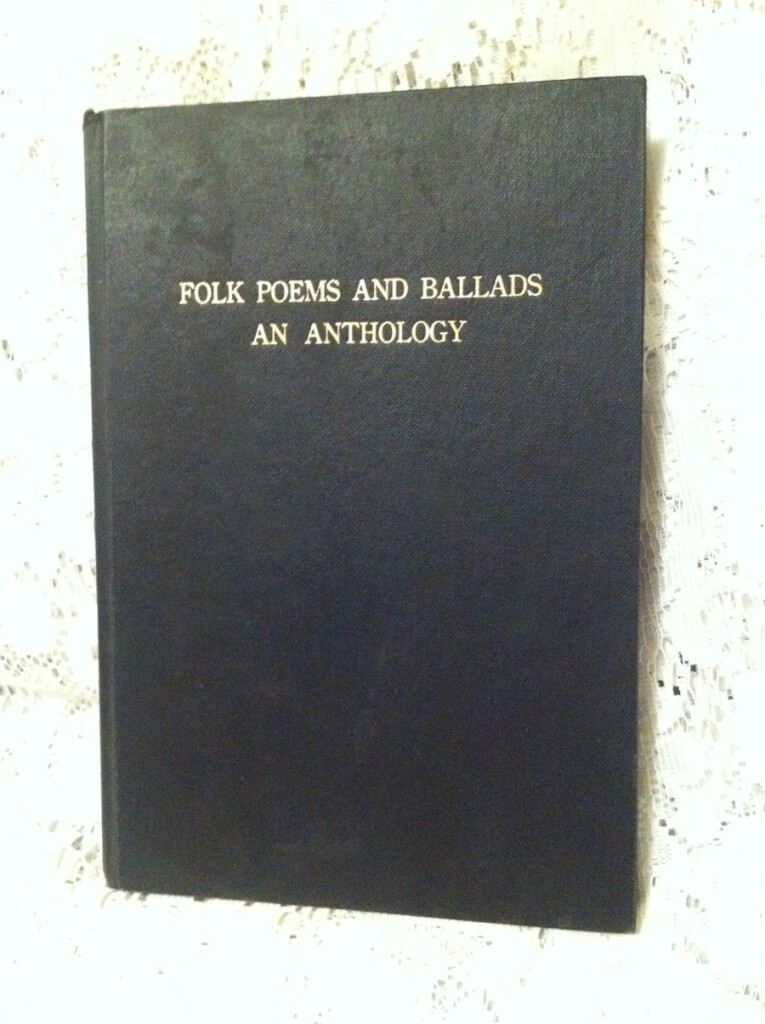 Folk Poems and Ballads An Anthology, anonymous [A. Reynolds Morse] ( Cruciform Press, Mexico City: Privately Printed for Private Circulation to Subscribers Only, 1944 [Cleveland, Ohio: A. Reynolds Morse, 1948.] #230/250) 8" X 5.5", vi 128pp. Hardbound, black cloth boards, gilt lettering on cover. Fair condition, 1st signature detached, 4th signature loose but holding (a common problem with these books), good copy of a poorly made book. Subtitled: "A collection of rare verses and amusing folk songs compiled from scarce and suppressed books as well as from verbal sources which modern prudery, false social customs, and intolerance laws have separated from the public and historical record." A. Reynolds Morse was an American, born in 1914, who died in 2000. He moved to Cleveland from Denver in 1941. An industrialist and philanthropist, he is best known for his activity in collecting works by Salvador Dali, and founding the Salvador Dali Museum. According to his obituary in the New York Times, Reynolds and his wife "embarked on a sometimes turbulent friendship with Dali and his wife, Gala". He also had a hobby of collecting and publishing works that other publishers would not print. Title page: "A collection of rare verses and amusing folk songs compiled from scarce and suppressed books as well as from verbal sources which modern prudery, false social customs, and intolerance have separated from the public and historical record." Mr. Morse also published "Limericks, A Facet of Our Culture". Both books were suppressed by police action in the late 1940's. This is the more rare of the two books.
Folk Poems and Ballads An Anthology, anonymous [A. Reynolds Morse] ( Cruciform Press, Mexico City: Privately Printed for Private Circulation to Subscribers Only, 1944 [Cleveland, Ohio: A. Reynolds Morse, 1948.] #230/250) 8" X 5.5", vi 128pp. Hardbound, black cloth boards, gilt lettering on cover. Fair condition, 1st signature detached, 4th signature loose but holding (a common problem with these books), good copy of a poorly made book. Subtitled: "A collection of rare verses and amusing folk songs compiled from scarce and suppressed books as well as from verbal sources which modern prudery, false social customs, and intolerance laws have separated from the public and historical record." A. Reynolds Morse was an American, born in 1914, who died in 2000. He moved to Cleveland from Denver in 1941. An industrialist and philanthropist, he is best known for his activity in collecting works by Salvador Dali, and founding the Salvador Dali Museum. According to his obituary in the New York Times, Reynolds and his wife "embarked on a sometimes turbulent friendship with Dali and his wife, Gala". He also had a hobby of collecting and publishing works that other publishers would not print. Title page: "A collection of rare verses and amusing folk songs compiled from scarce and suppressed books as well as from verbal sources which modern prudery, false social customs, and intolerance have separated from the public and historical record." Mr. Morse also published "Limericks, A Facet of Our Culture". Both books were suppressed by police action in the late 1940's. This is the more rare of the two books. -
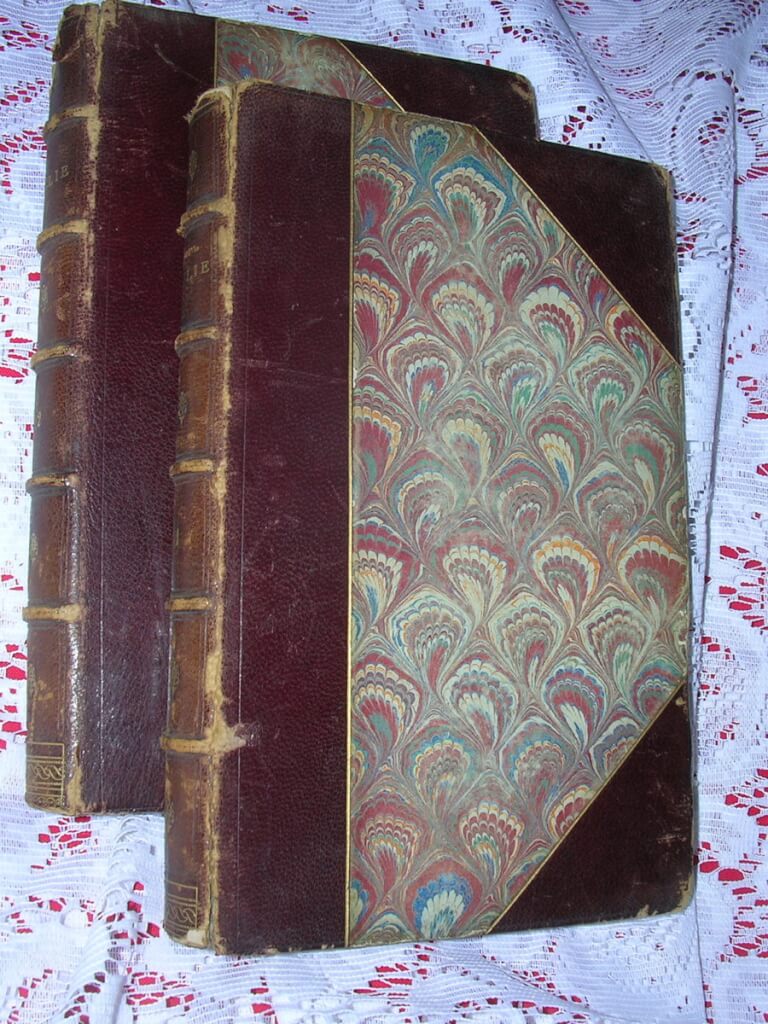
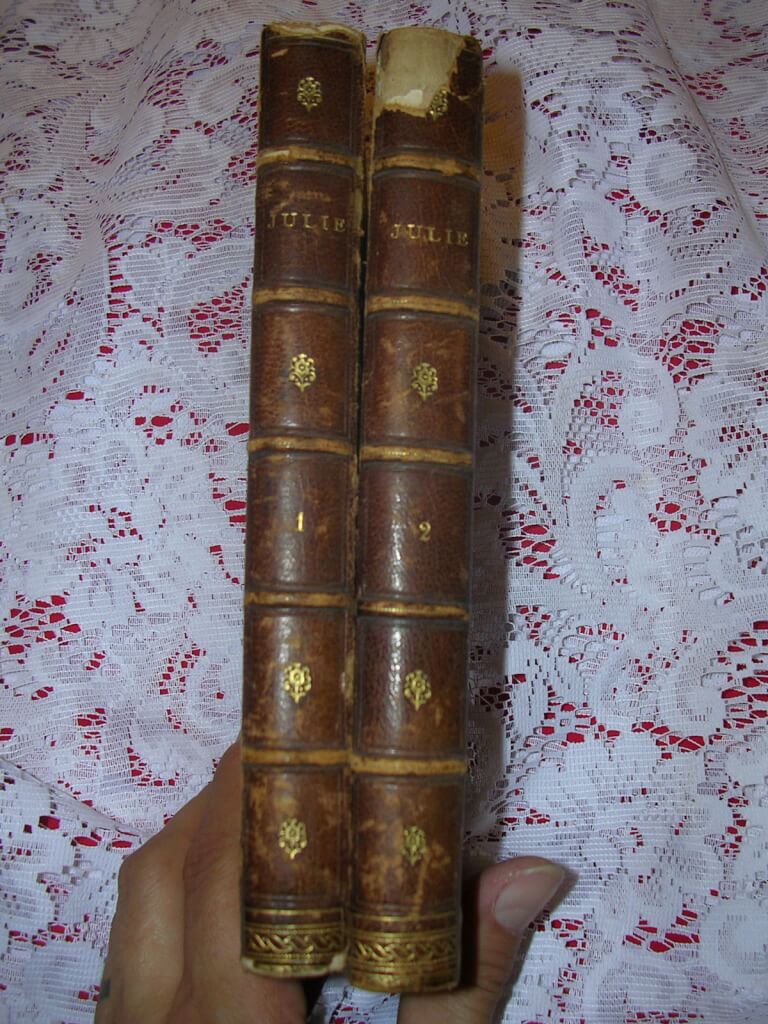 Julie, ou J'ai sauvé ma rose, Madame de C*** [Félicité Choiseul-Meuse] (Gay et Doucé, Bruxelles, 1882) 7.5" x 4.75", 2 vol. 169pp 188pp, hardbound half-leather over decorated paper boards and marbled endpapers. Gilt lettering and decorations on spine, 5 raised bands. 2 frontispiece engravings. Fair condition for age. Vol. 1 front boards loose and first few endpapers not attached, no missing pages, wear and tear to top of spine. Edges worn, corners bumped. Felicite de Choiseul-Meuse wrote approximately twenty-seven novels from 1797 to 1824. Writings are sometimes identified by pseudonyms and acronyms: LFDLC; Emilia P ***, Madame de C *** , etc.. Her 1807 novel "Julie, ou j'ai sauvé ma rose" [Julie, or I saved my rose] is widely considered the first erotic novel written by a woman. It is more appropriately translated as "how I kept my cherry" for it tells the tale of a young woman who lets her lovers fondle her all they want, but will not allow penetration until she finds the right man and marries him. The work was condemned as obscene and its destruction ordered by the Cour royale de Paris on August 5, 1828. Excerpt: "I tasted in his arms unspeakable pleasures. Deadened by pleasure, then revived by an even more delirious pleasure, I made the object of happiness almost as happy as I was myself; and yet, true to my system, I made sure that he did not harvest the rose."
Julie, ou J'ai sauvé ma rose, Madame de C*** [Félicité Choiseul-Meuse] (Gay et Doucé, Bruxelles, 1882) 7.5" x 4.75", 2 vol. 169pp 188pp, hardbound half-leather over decorated paper boards and marbled endpapers. Gilt lettering and decorations on spine, 5 raised bands. 2 frontispiece engravings. Fair condition for age. Vol. 1 front boards loose and first few endpapers not attached, no missing pages, wear and tear to top of spine. Edges worn, corners bumped. Felicite de Choiseul-Meuse wrote approximately twenty-seven novels from 1797 to 1824. Writings are sometimes identified by pseudonyms and acronyms: LFDLC; Emilia P ***, Madame de C *** , etc.. Her 1807 novel "Julie, ou j'ai sauvé ma rose" [Julie, or I saved my rose] is widely considered the first erotic novel written by a woman. It is more appropriately translated as "how I kept my cherry" for it tells the tale of a young woman who lets her lovers fondle her all they want, but will not allow penetration until she finds the right man and marries him. The work was condemned as obscene and its destruction ordered by the Cour royale de Paris on August 5, 1828. Excerpt: "I tasted in his arms unspeakable pleasures. Deadened by pleasure, then revived by an even more delirious pleasure, I made the object of happiness almost as happy as I was myself; and yet, true to my system, I made sure that he did not harvest the rose." -
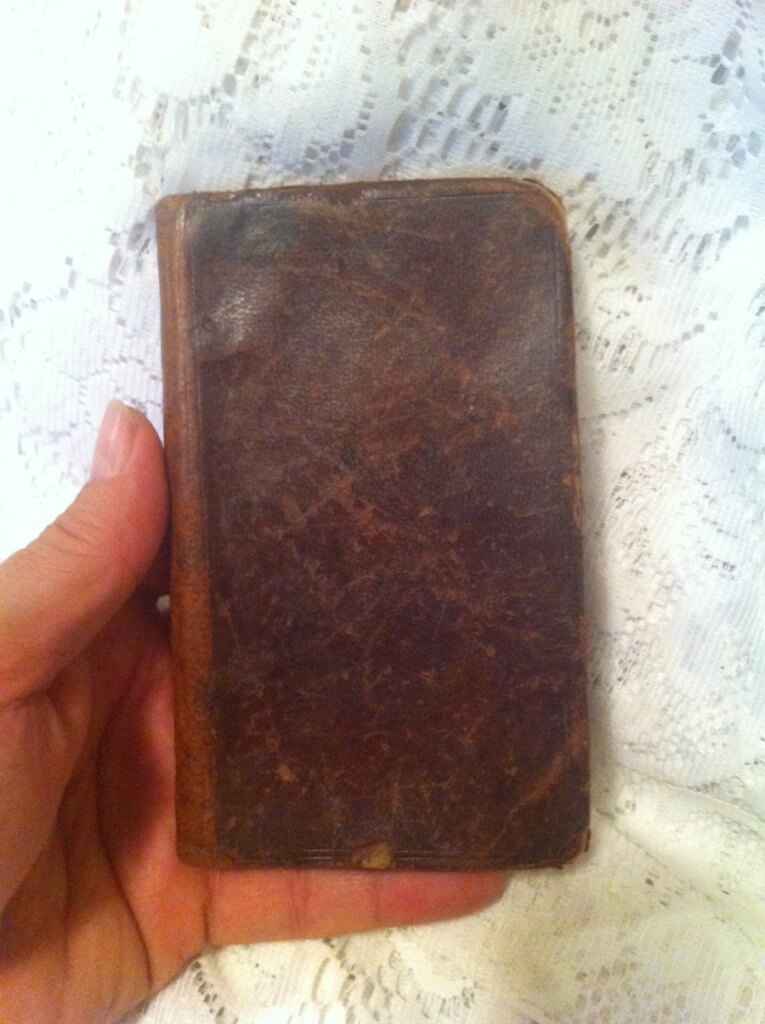
 The secret history of the most renowned Q. Elizabeth and the E. of Essex, "By a Person of Quality", ("Printed for R. Wellington, at the Dolphin and Crown in St. Paul's Churchyard, 1708. Where you may be furnish'd with all sorts of Plays.") 3.25"x5.5", in two parts with separate title pages 1-62,63-112pp(of 115?), bound in brown leather, no front or rear endpapers, not illustrated, poor condition, binding and boards are solid but pages soiled and edges tattered, page 111/112 piece torn off, pages 113-155 missing, writing (alphabet letters) near and on part one title page. By the late seventeenth century, Elizabeth's love life became a subject of obsession in England and especially in France. This book is the most famous of the absurd tattle-tale books. It was a translation of Comte d'Essex histoire angloise first published in 1678 by Claude Barbin – a Parisian publisher who edited the works of Molière, La Fontaine, Charles Perrault and Corneille. The earliest translations to english date show up around 1680. Most of them have a false imprint of "Cologne : Printed for Will with the Wisp". Few are seen with this particular imprint. The story was turned into a play and in 1912 adapted as a silent film entitled Les Amours de la reine Élisabeth starring Sarah Bernhardt as Elizabeth.
The secret history of the most renowned Q. Elizabeth and the E. of Essex, "By a Person of Quality", ("Printed for R. Wellington, at the Dolphin and Crown in St. Paul's Churchyard, 1708. Where you may be furnish'd with all sorts of Plays.") 3.25"x5.5", in two parts with separate title pages 1-62,63-112pp(of 115?), bound in brown leather, no front or rear endpapers, not illustrated, poor condition, binding and boards are solid but pages soiled and edges tattered, page 111/112 piece torn off, pages 113-155 missing, writing (alphabet letters) near and on part one title page. By the late seventeenth century, Elizabeth's love life became a subject of obsession in England and especially in France. This book is the most famous of the absurd tattle-tale books. It was a translation of Comte d'Essex histoire angloise first published in 1678 by Claude Barbin – a Parisian publisher who edited the works of Molière, La Fontaine, Charles Perrault and Corneille. The earliest translations to english date show up around 1680. Most of them have a false imprint of "Cologne : Printed for Will with the Wisp". Few are seen with this particular imprint. The story was turned into a play and in 1912 adapted as a silent film entitled Les Amours de la reine Élisabeth starring Sarah Bernhardt as Elizabeth. -
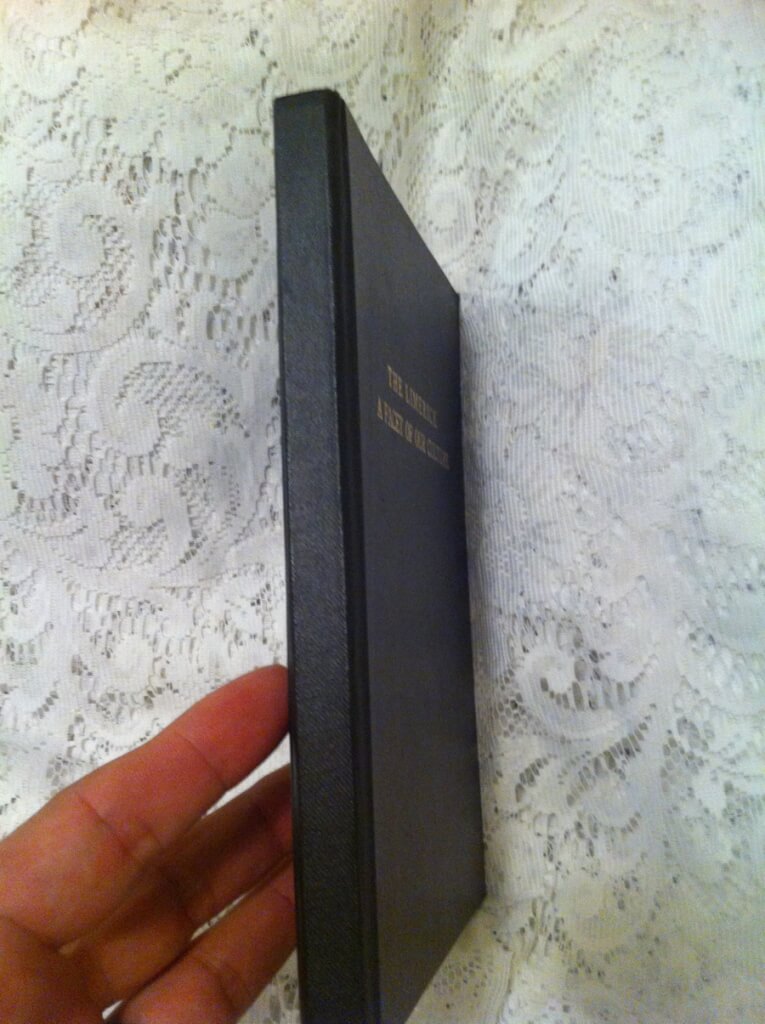
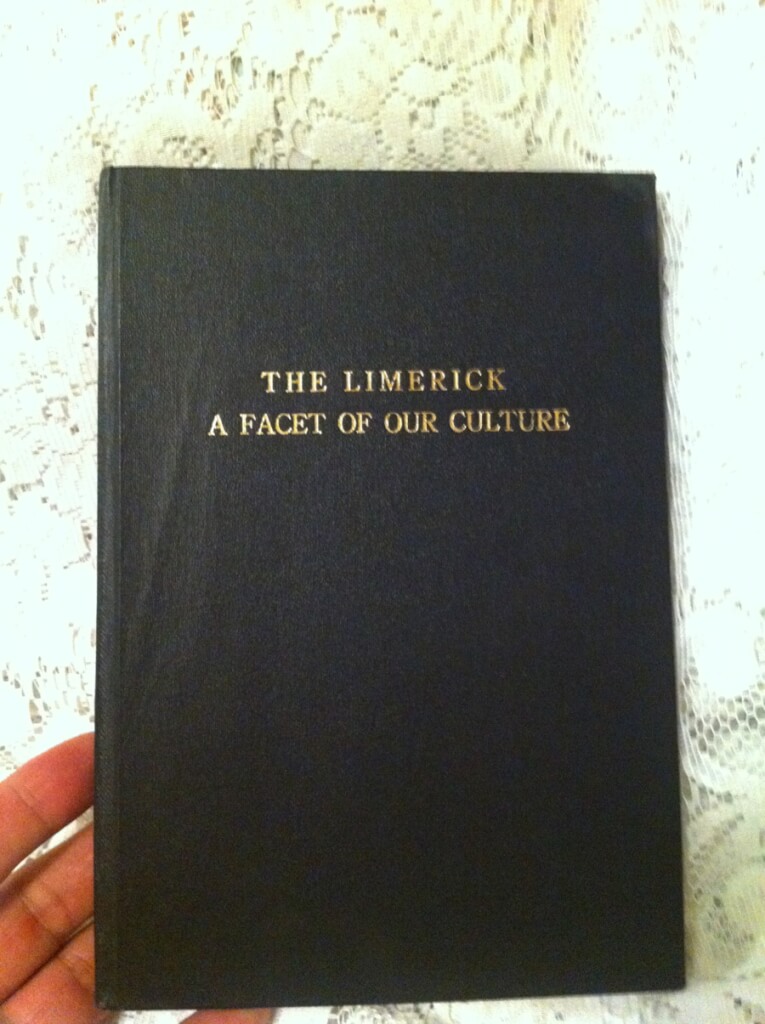 The Limerick, a facet of our culture, anonymous [A. Reynolds Morse] ( Cruciform Press, Mexico City: Privately Printed for Private Circulation to Subscribers Only, 1944 [Cleveland, Ohio: A. Reynolds Morse, 1948.] #208/250) 8" X 5.5", vii+157pp. Hardbound, black cloth boards, gilt lettering on cover. near fine condition (rare for this edition!), slight rust around staples. A. Reynolds Morse was an American, born in 1914, who died in 2000. He moved to Cleveland from Denver in 1941. An industrialist and philanthropist, he is best known for his activity in collecting works by Salvador Dali, and founding the Salvador Dali Museum. According to his obituary in the New York Times, Reynolds and his wife "embarked on a sometimes turbulent friendship with Dali and his wife, Gala". He also had a hobby of collecting and publishing works that other publishers would not print. Title page: "A study of the history and development of the limerick, ensplendor'd with over two hundred examples of the immortal verse form, commentaries, and index" This book is considered by most to be the "dirtiest" collection of limericks. Mr. Morse also published "Folk Poems and Ballads An Anthology". Both books were suppressed by police action in the late 1940's. This is a VERY rare near fine copy of this hard-to-find book. It was poorly made so most of the copies out there have signatures loose.
The Limerick, a facet of our culture, anonymous [A. Reynolds Morse] ( Cruciform Press, Mexico City: Privately Printed for Private Circulation to Subscribers Only, 1944 [Cleveland, Ohio: A. Reynolds Morse, 1948.] #208/250) 8" X 5.5", vii+157pp. Hardbound, black cloth boards, gilt lettering on cover. near fine condition (rare for this edition!), slight rust around staples. A. Reynolds Morse was an American, born in 1914, who died in 2000. He moved to Cleveland from Denver in 1941. An industrialist and philanthropist, he is best known for his activity in collecting works by Salvador Dali, and founding the Salvador Dali Museum. According to his obituary in the New York Times, Reynolds and his wife "embarked on a sometimes turbulent friendship with Dali and his wife, Gala". He also had a hobby of collecting and publishing works that other publishers would not print. Title page: "A study of the history and development of the limerick, ensplendor'd with over two hundred examples of the immortal verse form, commentaries, and index" This book is considered by most to be the "dirtiest" collection of limericks. Mr. Morse also published "Folk Poems and Ballads An Anthology". Both books were suppressed by police action in the late 1940's. This is a VERY rare near fine copy of this hard-to-find book. It was poorly made so most of the copies out there have signatures loose. -

 Les métamorphoses ou l'asne d'or de Luce Apulée philosophe platonique, Lucius Apuleius Madaurensis (124-170 AD), trans. Jules De Marthold, illust. [21 etchings] Martin van Maele (Charles Carrington, Librairie-Éditeur, 1905, Paris, #88/750) 9.25" X 6.25", xlviii+328pp., original soft wraps protected by glassine wraps, Chapter pieces in orange and black, tail pieces in black, large, decorative first letter of each chapter, frontispiece + 21 full-page b/w engravings with tissue guards and numerous in-text illustrations by Martin van Maele, very good condition for age. The Metamorphoses of Apuleius, which St. Augustine referred to as "The Golden Ass", is the only Ancient Roman novel in Latin to survive in its entirety. The plot Lucius and his curiosity and insatiable desire to see and practice magic. While trying to perform a spell to transform into a bird, he is accidentally transformed into an ass. This leads to a long journey, literal and metaphorical, filled with in-set tales. He finally finds salvation through the intervention of the goddess Isis, whose cult he joins. The date of the original work is uncertain. Scholars are not sure if he wrote it in his youth or at the end of his life. He adapted the story from a Greek story written by Lucius of Patrae, however his original Greek text has long been lost. Maurice François Alfred Martin van Miële (1863-5 - 1926), better known by his pseudonym Martin van Maële, was a French illustrator of early 20th century literature. Though he gained notoriety with his illustration for H. G. Wells in Les Premiers Hommes dans la Lune, and he worked as an illustrator for the Félix Juven's French translations of the Sherlock Holmes series, he is now most widely renowned and mostly remembered for his erotic illustrations. This is a beautiful and rare book in it's original paper wraps.
Les métamorphoses ou l'asne d'or de Luce Apulée philosophe platonique, Lucius Apuleius Madaurensis (124-170 AD), trans. Jules De Marthold, illust. [21 etchings] Martin van Maele (Charles Carrington, Librairie-Éditeur, 1905, Paris, #88/750) 9.25" X 6.25", xlviii+328pp., original soft wraps protected by glassine wraps, Chapter pieces in orange and black, tail pieces in black, large, decorative first letter of each chapter, frontispiece + 21 full-page b/w engravings with tissue guards and numerous in-text illustrations by Martin van Maele, very good condition for age. The Metamorphoses of Apuleius, which St. Augustine referred to as "The Golden Ass", is the only Ancient Roman novel in Latin to survive in its entirety. The plot Lucius and his curiosity and insatiable desire to see and practice magic. While trying to perform a spell to transform into a bird, he is accidentally transformed into an ass. This leads to a long journey, literal and metaphorical, filled with in-set tales. He finally finds salvation through the intervention of the goddess Isis, whose cult he joins. The date of the original work is uncertain. Scholars are not sure if he wrote it in his youth or at the end of his life. He adapted the story from a Greek story written by Lucius of Patrae, however his original Greek text has long been lost. Maurice François Alfred Martin van Miële (1863-5 - 1926), better known by his pseudonym Martin van Maële, was a French illustrator of early 20th century literature. Though he gained notoriety with his illustration for H. G. Wells in Les Premiers Hommes dans la Lune, and he worked as an illustrator for the Félix Juven's French translations of the Sherlock Holmes series, he is now most widely renowned and mostly remembered for his erotic illustrations. This is a beautiful and rare book in it's original paper wraps. -
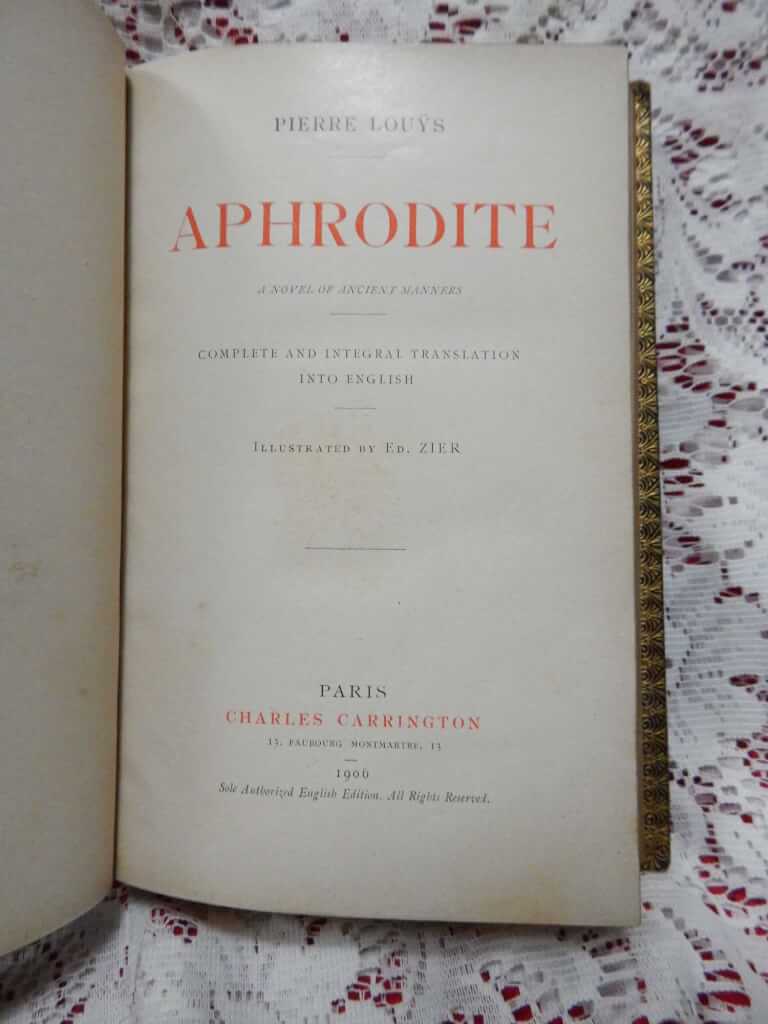
 Aphrodite, a novel of ancient manners, by Pierre Louÿs, illus. Ed. Zier (Charles Carrington, 1906, first edition thus, first English translation) 5.25 x 8", 412pp, full green moroccan, gilt lettering and decoration on spine and borders, 5 raised bands, gilt edges, gilt decorations boardering pastedown, near fine condition, some cracks in the hinges. Pierre Louys (1870 - 1925) was a French poet and writer, most renowned for lesbian and classical themes in some of his writings. He is known as a writer who "expressed pagan sensuality with stylistic perfection." "Aphrodite: mæurs antiques" (Ancient Manners) is a "libertine" story set in ancient Alexandria. Highlights include the loves of Chrysis, an orgy banquet ending in the crucifixion of a slave, the love of two young musician girls and the festivals of Aphrodite. "This Translation of Aphrodite was executed on the Printing Presses of Charles Herissey, at Evreux (France), for Mr. Charles Carrington, Paris, Bookseller et Publisher, and is the only complete English version extant." A beautiful example of this important first edition of the first translation. Very hard to find in full leather. Édouard François Zier (1856-1924) was a French illustrator and painter.
Aphrodite, a novel of ancient manners, by Pierre Louÿs, illus. Ed. Zier (Charles Carrington, 1906, first edition thus, first English translation) 5.25 x 8", 412pp, full green moroccan, gilt lettering and decoration on spine and borders, 5 raised bands, gilt edges, gilt decorations boardering pastedown, near fine condition, some cracks in the hinges. Pierre Louys (1870 - 1925) was a French poet and writer, most renowned for lesbian and classical themes in some of his writings. He is known as a writer who "expressed pagan sensuality with stylistic perfection." "Aphrodite: mæurs antiques" (Ancient Manners) is a "libertine" story set in ancient Alexandria. Highlights include the loves of Chrysis, an orgy banquet ending in the crucifixion of a slave, the love of two young musician girls and the festivals of Aphrodite. "This Translation of Aphrodite was executed on the Printing Presses of Charles Herissey, at Evreux (France), for Mr. Charles Carrington, Paris, Bookseller et Publisher, and is the only complete English version extant." A beautiful example of this important first edition of the first translation. Very hard to find in full leather. Édouard François Zier (1856-1924) was a French illustrator and painter. -
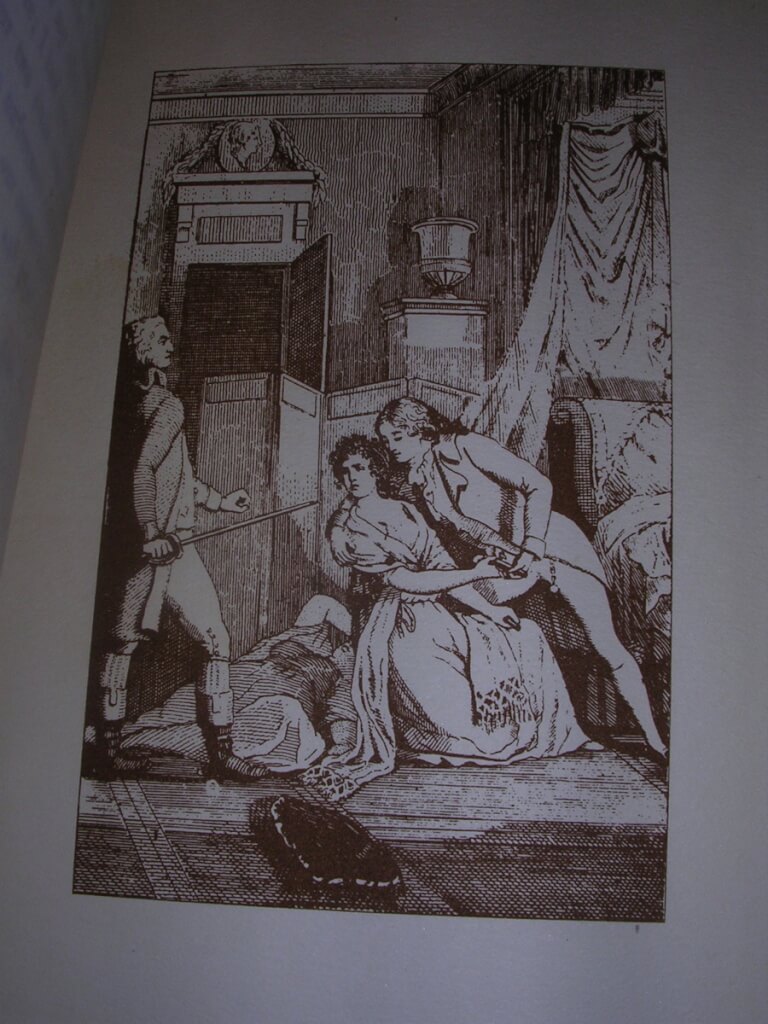
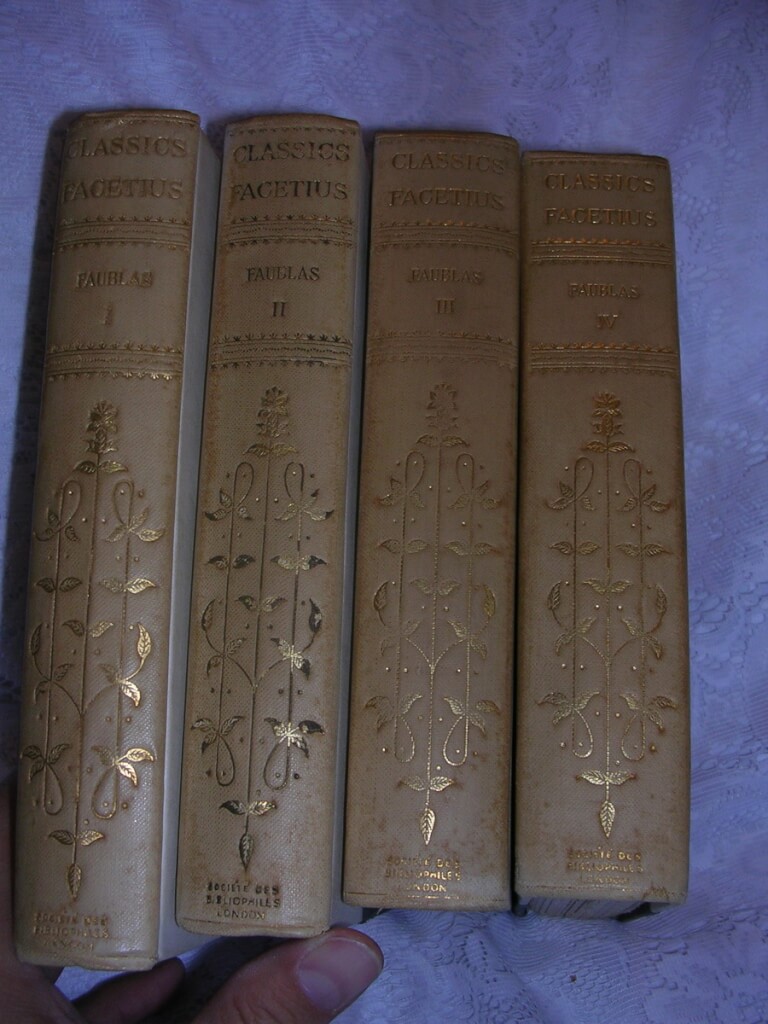 The Amours of the Chevalier de Faublas | by John Baptiste Louvet de Courvray | founded on historical facts, interspersed with most remarkable narratives | a literal unexpurgated translation from the Paris edition of 1821, etchings by Louis Monzies from drawings of Paul Avril (Privately Printed for Société des Bibliophiles [possibly Charles Carrington], London 1898, one of 100, first English translation edition) 5.75"x8.25", 4 volumes, ix+330pp, 367pp, 416pp, 430pp, white spine over green boards, gilt title ("Classics Facetius | Faublas") and decorations on spine, top edge gilt, others deckled, many pages unopened, spine slightly soiled, slight sunning, otherwise in excellent condition for age, numerous illustrations with titled tissue guards. This is the first English translation of this work which, when published was a "sensation" all over Europe. It appears to be published by Charles Carrington, who occasionally used the Société des Bibliophiles imprint and often used illustrations from Paul Avril. Édouard-Henri Avril (1849-1928) used the pseudonym "Paul Avril" for his erotic work. He was a French painter and commercial artist. His career saw collaboration with influential people like Octave Uzanne, Henry Spencer Ashbee and Friedrich Karl Forberg. He is one of the most celebrated erotic artists of his age. Avril was a soldier before starting his career in art. He was awarded with the Legion of Honour for his actions in the Franco-Prussian War. Jean-Baptiste Louvet de Couvrai (1760 - 1797) was born in Paris as the son of a stationer, he became a bookseller's clerk, and first attracted attention with the first part of his novel "Les Amours du chevalier de Faublas" (5 parts) in 1787; it was followed in 1788 by "Six semaines de la vie du chevalier de Faublas" (8 parts) and in 1790 by "La Fin des amours du chevalier de Faublas" (6 parts). The heroine, Lodoiska, was modeled on the wife of a jeweler in the Palais Royal, with whom he had an affair. She divorced her husband in 1792 and married Louvet in 1793. This is considered a so-called "libertine" novel. It dwells mainly on the sexual escapades of its hero, a sort of amiable young libertine, and on the corrupted morals of eighteenth-century France. At the start of this novel the young Chevalier de Faublas attends a party dressed as a woman and is knowingly seduced by the lady of the house ('. I receive with equal astonishment and pleasure a charming lesson, which I repeated more than once .') Oxford Comp. to French Literature says it is "typical of many frivolous, licentious novels of its time, and still mentioned. Faublas, the amiable hero, is the victim of his own charms. His amorous adventures, recounted with a certain lively force, begin with his entry into society at the age of sixteen. He loves several women by the way and three in particular. A jealous husband and a despairing suicide reduce the three to one. The novel ends on a moral note: Faublas , who had happened to settle down with his remaining love, is haunted by the avenging phantoms of the other two and goes mad."
The Amours of the Chevalier de Faublas | by John Baptiste Louvet de Courvray | founded on historical facts, interspersed with most remarkable narratives | a literal unexpurgated translation from the Paris edition of 1821, etchings by Louis Monzies from drawings of Paul Avril (Privately Printed for Société des Bibliophiles [possibly Charles Carrington], London 1898, one of 100, first English translation edition) 5.75"x8.25", 4 volumes, ix+330pp, 367pp, 416pp, 430pp, white spine over green boards, gilt title ("Classics Facetius | Faublas") and decorations on spine, top edge gilt, others deckled, many pages unopened, spine slightly soiled, slight sunning, otherwise in excellent condition for age, numerous illustrations with titled tissue guards. This is the first English translation of this work which, when published was a "sensation" all over Europe. It appears to be published by Charles Carrington, who occasionally used the Société des Bibliophiles imprint and often used illustrations from Paul Avril. Édouard-Henri Avril (1849-1928) used the pseudonym "Paul Avril" for his erotic work. He was a French painter and commercial artist. His career saw collaboration with influential people like Octave Uzanne, Henry Spencer Ashbee and Friedrich Karl Forberg. He is one of the most celebrated erotic artists of his age. Avril was a soldier before starting his career in art. He was awarded with the Legion of Honour for his actions in the Franco-Prussian War. Jean-Baptiste Louvet de Couvrai (1760 - 1797) was born in Paris as the son of a stationer, he became a bookseller's clerk, and first attracted attention with the first part of his novel "Les Amours du chevalier de Faublas" (5 parts) in 1787; it was followed in 1788 by "Six semaines de la vie du chevalier de Faublas" (8 parts) and in 1790 by "La Fin des amours du chevalier de Faublas" (6 parts). The heroine, Lodoiska, was modeled on the wife of a jeweler in the Palais Royal, with whom he had an affair. She divorced her husband in 1792 and married Louvet in 1793. This is considered a so-called "libertine" novel. It dwells mainly on the sexual escapades of its hero, a sort of amiable young libertine, and on the corrupted morals of eighteenth-century France. At the start of this novel the young Chevalier de Faublas attends a party dressed as a woman and is knowingly seduced by the lady of the house ('. I receive with equal astonishment and pleasure a charming lesson, which I repeated more than once .') Oxford Comp. to French Literature says it is "typical of many frivolous, licentious novels of its time, and still mentioned. Faublas, the amiable hero, is the victim of his own charms. His amorous adventures, recounted with a certain lively force, begin with his entry into society at the age of sixteen. He loves several women by the way and three in particular. A jealous husband and a despairing suicide reduce the three to one. The novel ends on a moral note: Faublas , who had happened to settle down with his remaining love, is haunted by the avenging phantoms of the other two and goes mad." -
 The Lysistrata of Aristophanes | Wholly translated into English and illustrated with eight full-page drawings by Aubrey Beardsley with a preface on Aristophanic Comedy and its reflection in the art of the Illustrator by George Frederic Lees, Aristophanes, illus. by Aubrey Beardsley, forward by George Frederic Lees (Privately Printed in Paris, 1931, #352/525) 11.25" X 9.25", 61pp, loosely bound with loose cover, with original slip-case, printed on hand-made Van Gelder paper, 8 illustrations printed on mould-made Annoy Paper, interior pages clean and in fine condition, slip-case is in poor condition, some soiling on the cover. Aristophanes was the greatest writer of ancient Athenian “old comedy,” known for its satires of contemporary life and for its broad, often obscene humor. Lysistrata was first produced in 411 BC, when the Peloponnesian War had been devastating Greece for 20 years. Most people know the plot: Lysistrata assembles women from all of Greece, and they agree that they will not have sex until the men make peace. Aubrey Beardsley was the greatest and the most controversial Art Nouveau illustrator in England, famous for his illustrations of Mallory’s Morte d’Arthur, Oscar Wilde’s Salome, Pope’s The Rape of the Lock, and for several magazines. Because he was associated with Oscar Wilde, Beardsley lost his job as art editor of a magazine named The Yellow Book in 1895, soon after Wilde was arrested for homosexuality. He was approached by Leonard Smithers, a publisher of erotic books, who asked him to illustrate Lysistrata. His illustrations are very much in the spirit of Aristophanes, as funny as they are obscene. Beardsley converted to Catholicism in 1897, and soon after, he asked Smithers to “destroy all copies of Lysistrata” with its “obscene drawings,” but Smithers refused. Beardsley died of tuberculosis in 1898, at the age of 26. Smithers initially published Lysistrata in a limited edition of one hundred copies. It was occasionally reprinted in very small runs, usually clandestinely, often poorly, but copies have long been scarce and expensive. I have only found this copy a few places outside of museums and libraries. This is a rare fine reproduction of the original drawings on quality paper. I do not have information about the actual publisher.
The Lysistrata of Aristophanes | Wholly translated into English and illustrated with eight full-page drawings by Aubrey Beardsley with a preface on Aristophanic Comedy and its reflection in the art of the Illustrator by George Frederic Lees, Aristophanes, illus. by Aubrey Beardsley, forward by George Frederic Lees (Privately Printed in Paris, 1931, #352/525) 11.25" X 9.25", 61pp, loosely bound with loose cover, with original slip-case, printed on hand-made Van Gelder paper, 8 illustrations printed on mould-made Annoy Paper, interior pages clean and in fine condition, slip-case is in poor condition, some soiling on the cover. Aristophanes was the greatest writer of ancient Athenian “old comedy,” known for its satires of contemporary life and for its broad, often obscene humor. Lysistrata was first produced in 411 BC, when the Peloponnesian War had been devastating Greece for 20 years. Most people know the plot: Lysistrata assembles women from all of Greece, and they agree that they will not have sex until the men make peace. Aubrey Beardsley was the greatest and the most controversial Art Nouveau illustrator in England, famous for his illustrations of Mallory’s Morte d’Arthur, Oscar Wilde’s Salome, Pope’s The Rape of the Lock, and for several magazines. Because he was associated with Oscar Wilde, Beardsley lost his job as art editor of a magazine named The Yellow Book in 1895, soon after Wilde was arrested for homosexuality. He was approached by Leonard Smithers, a publisher of erotic books, who asked him to illustrate Lysistrata. His illustrations are very much in the spirit of Aristophanes, as funny as they are obscene. Beardsley converted to Catholicism in 1897, and soon after, he asked Smithers to “destroy all copies of Lysistrata” with its “obscene drawings,” but Smithers refused. Beardsley died of tuberculosis in 1898, at the age of 26. Smithers initially published Lysistrata in a limited edition of one hundred copies. It was occasionally reprinted in very small runs, usually clandestinely, often poorly, but copies have long been scarce and expensive. I have only found this copy a few places outside of museums and libraries. This is a rare fine reproduction of the original drawings on quality paper. I do not have information about the actual publisher. -
 The Dialogues of Luisa Sigea, Nicolas Chorier, translation by Isadore Liseux (Isadore Liseux, Paris, 1890, first edition, first English translation, printed by Ch. Unsinger) 8.75" X 5.75", 3 books bound in one, xx+87pp, 132pp, 98+2pp, 3/4 crimson morocco over red boards, 5 raised bands, gilt decorations and titles on spine, marbled endpapers, top edge gilt, others deckled. Excellent condition for age, very minor bumping on corners and top and bottom of spine. In six dialogues (I. The skirmish; II. Tribadicon; III. Fabric; IV. The duel; V. Pleasures; VI. Frolics and sports) Tullia, who is 26, initiates her 15 year old cousin, Ottavia, in the art of sexual pleasure. The first four dialogues, which are fairly short, focus on tribadism and defloration. The longer fifth and six dialogues introduce flagellation, contractual submission, group sex, and anal sex. Like many sexual fictions, The Dialogues of Luisa Sigea (originally written in latin "Aloisiae Sigeae Satyra Sotadica de arcanis Amoris et Veneris") attempts to conceal the identity of its author: it purports to be based on a Latin manuscript translation of a work written originally in Spanish in the sixteenth century by an erudite young woman, Luisa Sigea of Toledo and translated into latin by Jean Meursius of Holland. In fact, it was written c. 1660, in latin, by a Frenchman, Nicolas Chorier (1612-1692), a lawyer who wrote works on various historical and philosophical subjects. The first first French translation, L’Academie des dames, was issued in the 1680. This 1890 edition was for the first time translated into English by Isidore Liseux and issued as a 3 volume set. (1. I-IV, 2. V, 3. VI). Isidore Liseux (1835-1894) was a French bibliophile and publisher of erotica and curiosa. His publications were mostly rare texts of 16th to 18th century authors, hard to find and little known books which were usually translated and annotated by his friend and associate Alcide Bonneau or by Liseux himself. Liseux and Bonneau, both ex-priests, knew each other since seminary. His books were published in small numbers, on high quality paper, and with excellent typography. His usual printers were Claude Motteroz, Antoine Bécus, and later Charles Unsinger. Liseux's books were published openly as the climate was more permissive in Paris at the time. His books were so well regarded that pirates of his books and even unrelated books bearing his imprint with a false date were published clandestinely into the 20th century. French poet, Guillaume Apollinaire wrote: "The publications of Liseux are more and more sought after because they are correct, beautiful and rare." (Le flaneur des deux rives, 1918).
The Dialogues of Luisa Sigea, Nicolas Chorier, translation by Isadore Liseux (Isadore Liseux, Paris, 1890, first edition, first English translation, printed by Ch. Unsinger) 8.75" X 5.75", 3 books bound in one, xx+87pp, 132pp, 98+2pp, 3/4 crimson morocco over red boards, 5 raised bands, gilt decorations and titles on spine, marbled endpapers, top edge gilt, others deckled. Excellent condition for age, very minor bumping on corners and top and bottom of spine. In six dialogues (I. The skirmish; II. Tribadicon; III. Fabric; IV. The duel; V. Pleasures; VI. Frolics and sports) Tullia, who is 26, initiates her 15 year old cousin, Ottavia, in the art of sexual pleasure. The first four dialogues, which are fairly short, focus on tribadism and defloration. The longer fifth and six dialogues introduce flagellation, contractual submission, group sex, and anal sex. Like many sexual fictions, The Dialogues of Luisa Sigea (originally written in latin "Aloisiae Sigeae Satyra Sotadica de arcanis Amoris et Veneris") attempts to conceal the identity of its author: it purports to be based on a Latin manuscript translation of a work written originally in Spanish in the sixteenth century by an erudite young woman, Luisa Sigea of Toledo and translated into latin by Jean Meursius of Holland. In fact, it was written c. 1660, in latin, by a Frenchman, Nicolas Chorier (1612-1692), a lawyer who wrote works on various historical and philosophical subjects. The first first French translation, L’Academie des dames, was issued in the 1680. This 1890 edition was for the first time translated into English by Isidore Liseux and issued as a 3 volume set. (1. I-IV, 2. V, 3. VI). Isidore Liseux (1835-1894) was a French bibliophile and publisher of erotica and curiosa. His publications were mostly rare texts of 16th to 18th century authors, hard to find and little known books which were usually translated and annotated by his friend and associate Alcide Bonneau or by Liseux himself. Liseux and Bonneau, both ex-priests, knew each other since seminary. His books were published in small numbers, on high quality paper, and with excellent typography. His usual printers were Claude Motteroz, Antoine Bécus, and later Charles Unsinger. Liseux's books were published openly as the climate was more permissive in Paris at the time. His books were so well regarded that pirates of his books and even unrelated books bearing his imprint with a false date were published clandestinely into the 20th century. French poet, Guillaume Apollinaire wrote: "The publications of Liseux are more and more sought after because they are correct, beautiful and rare." (Le flaneur des deux rives, 1918). -
Out of stock
 Memoirs of Cardinal Dubois | translated from the French by Ernest Dowson | with photogravure portraits of Cardinal Dubois and the Duc d'Orleans (Leonard Smithers and Co, London, 1899, First Edition thus, first English translation) 9.75"x6.5", 2 volumes, xvi-282pp, viii-268pp, blue boards with gilt decoration and titles on spine, deckled edges, good condition, bumping to corners, bookplates for Reginald Dalton Pontifex in both volumes. According to the publisher, the original manuscript which was written entirely in Dubois hand was stolen by his secretary Lavergne after his death in 1723. It was later discovered of its literary value that Lavergne attempted to sell the manuscript. He was found and arrested. They later fell into the hands of Comte de Maurepas, then upon his death they were passed on to an anonymous writer named Mercier (possibly M. Paul Laroix) whose family had it published in 1829. The manuscript then became lost. In 1899 and English version of the book translated by Ernest Christopher Dowson, was published by the notorious pornographer, Leonard Smithers & Co. This is, presumably a reprinting of that translation. Guillaume Dubois (1656-1723), a son of a country doctor, rose from humble beginnings to positions of power and high honor in government and in the Catholic Church. He is best known for negotiating the Triple Alliance of 1717 between France, the Dutch Republic and Great Britain against their mutual enemy, Spain. Considered one of the four great French Cardinal-Ministers (Richelieu, Mazarin, Dubois, and Fleury). His ecclesiastical career left a great deal to be desired. Although there is no proof of the prevalent assertion that he got secretly married, his licentiousness, and notorious impiety, even at the time of his death, make it evident that he pursued and used ecclesiastical dignities principally to enhance his political position and prestige. Eventually in 1721, Du Bois was created cardinal. He had the reputation of a libertine and adventurer and made plenty of enemies. One of his rivals was charged at creating his portrait, the Duc de Saint-Simon, who was said to have placed a painting of Dubois in his lavatory. Saint-Simon had this to say about the Cardinal: "He was a little, pitiful, wizened, herring-gutted man, in a flaxen wig, with a weasel's face, brightened by some intellect. All the vices - perfidy, avarice, debauchery, ambition, flattery - fought within him for the mastery. He was so consummate a liar that, when taken in the fact, he could brazenly deny it. Even his wit and knowledge of the world were spoiled, and his affected gaiety was touched with sadness, by the odour of falsehood which escaped through every pore of his body." This famous picture is certainly biased. Dubois was unscrupulous, but so were his contemporaries, and whatever vices he had, he forged a European peace that, with the exception of small, restrained military expeditions against the Austrian Habsburgs, would last for a quarter of a century. Leonard Smithers (1861-1907), a solicitor born in Sheffield, was one of the most notable publishers of erotica of his day. He was said to be a brilliant but shady character who operated on the fringes of the rare book trade, issuing small, clandestine editions of risqué books with the boast: 'I will publish the things the others are afraid to touch'. He was notorious for posting a slogan at his bookshop in Bond Street reading "Smut is cheap today". He developed a friendship with Sir Richard Francis Burton and published Burton's famous translation of the Book of One Thousand and One Nights in 1885. He also worked with, among others, Aubrey Beardsley, Aleister Crowley, and Oscar Wilde. With Beardsley and Arthur Symons, he founded The Savoy, a periodical which ran for eight issues in 1896. Smithers famously partnered with Harry Nichols to publish a series of pornographic books under the Erotika Biblion Society imprint. When Beardsley, on his death bed, converted to Catholicism and asked Smithers to “destroy all copies of Lysistrata and bad drawings...by all that is holy all obscene drawings.", Smithers, famously and thankfully ignored him and continued to publish his works until his death in 1907. It was Smithers who published Oscar Wilde's The Ballad of Reading Gaol, a long poem commemorating the harsh rhythms of prison life in 1898. Smithers went bankrupt in 1900 and died impoverished in 1907 from cirrhosis of the liver. Up until his death he continued to sell reproductions (and forgeries) of Beardsley's work as well as reproductions of the Beardsley's letter asking him to destroy his drawings. Reginald Dalton Pontifex (1857–1951) was born in France, attended Magdalen College at Oxford from 1876–80, getting a Fourth in Law in 1880 and a Third in his BCL in 1882. He later practiced as a barrister. At the time of his death it was said he had quite the book collection containing, several of antiquarian interest. He bequethed his book collection to his alma mater. Most of his books were printed in the early nineteenth century and many of them extensively illustrated. He died in Bournemouth, Hampshire, England in 1951.
Memoirs of Cardinal Dubois | translated from the French by Ernest Dowson | with photogravure portraits of Cardinal Dubois and the Duc d'Orleans (Leonard Smithers and Co, London, 1899, First Edition thus, first English translation) 9.75"x6.5", 2 volumes, xvi-282pp, viii-268pp, blue boards with gilt decoration and titles on spine, deckled edges, good condition, bumping to corners, bookplates for Reginald Dalton Pontifex in both volumes. According to the publisher, the original manuscript which was written entirely in Dubois hand was stolen by his secretary Lavergne after his death in 1723. It was later discovered of its literary value that Lavergne attempted to sell the manuscript. He was found and arrested. They later fell into the hands of Comte de Maurepas, then upon his death they were passed on to an anonymous writer named Mercier (possibly M. Paul Laroix) whose family had it published in 1829. The manuscript then became lost. In 1899 and English version of the book translated by Ernest Christopher Dowson, was published by the notorious pornographer, Leonard Smithers & Co. This is, presumably a reprinting of that translation. Guillaume Dubois (1656-1723), a son of a country doctor, rose from humble beginnings to positions of power and high honor in government and in the Catholic Church. He is best known for negotiating the Triple Alliance of 1717 between France, the Dutch Republic and Great Britain against their mutual enemy, Spain. Considered one of the four great French Cardinal-Ministers (Richelieu, Mazarin, Dubois, and Fleury). His ecclesiastical career left a great deal to be desired. Although there is no proof of the prevalent assertion that he got secretly married, his licentiousness, and notorious impiety, even at the time of his death, make it evident that he pursued and used ecclesiastical dignities principally to enhance his political position and prestige. Eventually in 1721, Du Bois was created cardinal. He had the reputation of a libertine and adventurer and made plenty of enemies. One of his rivals was charged at creating his portrait, the Duc de Saint-Simon, who was said to have placed a painting of Dubois in his lavatory. Saint-Simon had this to say about the Cardinal: "He was a little, pitiful, wizened, herring-gutted man, in a flaxen wig, with a weasel's face, brightened by some intellect. All the vices - perfidy, avarice, debauchery, ambition, flattery - fought within him for the mastery. He was so consummate a liar that, when taken in the fact, he could brazenly deny it. Even his wit and knowledge of the world were spoiled, and his affected gaiety was touched with sadness, by the odour of falsehood which escaped through every pore of his body." This famous picture is certainly biased. Dubois was unscrupulous, but so were his contemporaries, and whatever vices he had, he forged a European peace that, with the exception of small, restrained military expeditions against the Austrian Habsburgs, would last for a quarter of a century. Leonard Smithers (1861-1907), a solicitor born in Sheffield, was one of the most notable publishers of erotica of his day. He was said to be a brilliant but shady character who operated on the fringes of the rare book trade, issuing small, clandestine editions of risqué books with the boast: 'I will publish the things the others are afraid to touch'. He was notorious for posting a slogan at his bookshop in Bond Street reading "Smut is cheap today". He developed a friendship with Sir Richard Francis Burton and published Burton's famous translation of the Book of One Thousand and One Nights in 1885. He also worked with, among others, Aubrey Beardsley, Aleister Crowley, and Oscar Wilde. With Beardsley and Arthur Symons, he founded The Savoy, a periodical which ran for eight issues in 1896. Smithers famously partnered with Harry Nichols to publish a series of pornographic books under the Erotika Biblion Society imprint. When Beardsley, on his death bed, converted to Catholicism and asked Smithers to “destroy all copies of Lysistrata and bad drawings...by all that is holy all obscene drawings.", Smithers, famously and thankfully ignored him and continued to publish his works until his death in 1907. It was Smithers who published Oscar Wilde's The Ballad of Reading Gaol, a long poem commemorating the harsh rhythms of prison life in 1898. Smithers went bankrupt in 1900 and died impoverished in 1907 from cirrhosis of the liver. Up until his death he continued to sell reproductions (and forgeries) of Beardsley's work as well as reproductions of the Beardsley's letter asking him to destroy his drawings. Reginald Dalton Pontifex (1857–1951) was born in France, attended Magdalen College at Oxford from 1876–80, getting a Fourth in Law in 1880 and a Third in his BCL in 1882. He later practiced as a barrister. At the time of his death it was said he had quite the book collection containing, several of antiquarian interest. He bequethed his book collection to his alma mater. Most of his books were printed in the early nineteenth century and many of them extensively illustrated. He died in Bournemouth, Hampshire, England in 1951. -
 Le Hazard du coin du feu, dialogue moral [The Opportunities of the Fireside, a moral dialogue], Crébillon fils (a la Haye, 1763, first edition) 6.25" X 3.75", 260pp, full leather, 5 raised bands and gilt titles on spine and decorating pastedowns, gilt edges, good+ condition, minor bumping to corners, armorial bookplate of Francis John Hughes in front pastedown, Mr. Hughes wrote inside "from the collection of Wallace Stevens. Bought at auction this day 10 March 1959 - FJH" The entire book is a dialogue takes place at Célie's house in a small secluded boudoir and the subject is the deceptions and tricks of debauchery, described through stories, dialogues, and tales by the participants. Claude Prosper Jolyot de Crébillon (1707 – 1777), was a French novelist. He was called "Crébillon fils" to distinguish him from his father, a famous tragedian, Prosper Jolyot de Crébillon. He received a Jesuit education at the elite Lycée Louis-le-Grand. Early on he composed various light works, including plays for the Italian Theatre in Paris, and published a short tale called Le Sylphe in 1730. From 1729 to 1739 he participated in a series of dinners called "Le Caveau" (named after the cabaret where they were held) with other artists, including Alexis Piron, Charles Collé, and Charles Duclos. The publication of Tanzaï et Néadarné, histoire japonaise (1734), which contained thinly veiled attacks on the Papal bull Unigenitus, the cardinal de Rohan and others, landed him briefly in the prison at Vincennes. Publication of Le Sopha, conte moral, an erotic political satire, in 1742 forced him into exile from Paris for several months. Wallace Stevens (1879-1955) was an American modernist poet. He won the Pulitzer Prize for Poetry for his Collected Poems in 1955.
Le Hazard du coin du feu, dialogue moral [The Opportunities of the Fireside, a moral dialogue], Crébillon fils (a la Haye, 1763, first edition) 6.25" X 3.75", 260pp, full leather, 5 raised bands and gilt titles on spine and decorating pastedowns, gilt edges, good+ condition, minor bumping to corners, armorial bookplate of Francis John Hughes in front pastedown, Mr. Hughes wrote inside "from the collection of Wallace Stevens. Bought at auction this day 10 March 1959 - FJH" The entire book is a dialogue takes place at Célie's house in a small secluded boudoir and the subject is the deceptions and tricks of debauchery, described through stories, dialogues, and tales by the participants. Claude Prosper Jolyot de Crébillon (1707 – 1777), was a French novelist. He was called "Crébillon fils" to distinguish him from his father, a famous tragedian, Prosper Jolyot de Crébillon. He received a Jesuit education at the elite Lycée Louis-le-Grand. Early on he composed various light works, including plays for the Italian Theatre in Paris, and published a short tale called Le Sylphe in 1730. From 1729 to 1739 he participated in a series of dinners called "Le Caveau" (named after the cabaret where they were held) with other artists, including Alexis Piron, Charles Collé, and Charles Duclos. The publication of Tanzaï et Néadarné, histoire japonaise (1734), which contained thinly veiled attacks on the Papal bull Unigenitus, the cardinal de Rohan and others, landed him briefly in the prison at Vincennes. Publication of Le Sopha, conte moral, an erotic political satire, in 1742 forced him into exile from Paris for several months. Wallace Stevens (1879-1955) was an American modernist poet. He won the Pulitzer Prize for Poetry for his Collected Poems in 1955. -
 Aristophanes: Lysistrata, Aristophanes, illus. by Aubrey Beardsley (Beardsley Press, 1927, one of 750 unnumbered) 8.25″ x 11.5″, 99pp, quarter silver over black cloth, with silver and black patterned endpapers, black lettering to spine, good condition for age, bumping and scraping present, Beardsley’s prints are tipped in. Aristophanes was the greatest writer of ancient Athenian “old comedy,” known for its satires of contemporary life and for its broad, often obscene humor. Lysistrata was first produced in 411 BC, when the Peloponnesian War had been devastating Greece for 20 years. Most people know the plot: Lysistrata assembles women from all of Greece, and they agree that they will not have sex until the men make peace. Aubrey Beardsley was the greatest and the most controversial Art Nouveau illustrator in England, famous for his illustrations of Mallory’s Morte d’Arthur, Oscar Wilde’s Salome, Pope’s The Rape of the Lock, and for several magazines. Because he was associated with Oscar Wilde, Beardsley lost his job as art editor of a magazine named The Yellow Book in 1895, soon after Wilde was arrested for homosexuality. He was approached by Leonard Smithers, a publisher of erotic books, who asked him to illustrate Lysistrata. His illustrations are very much in the spirit of Aristophanes, as funny as they are obscene. Beardsley converted to Catholicism in 1897, and soon after, he asked Smithers to “destroy all copies of Lysistrata” with its “obscene drawings,” but Smithers refused. Beardsley died of tuberculosis in 1898, at the age of 26. Smithers initially published Lysistrata in a limited edition of one hundred copies. It was occasionally reprinted in very small runs, usually clandestinely, often poorly, but copies have long been scarce and expensive. Few copies of Beardsley’s Lysistrata printed before 1966 are currently in circulation. This copy is a rare limited edition printed by the Beardsley Press, London and even rarer with the binding intact.
Aristophanes: Lysistrata, Aristophanes, illus. by Aubrey Beardsley (Beardsley Press, 1927, one of 750 unnumbered) 8.25″ x 11.5″, 99pp, quarter silver over black cloth, with silver and black patterned endpapers, black lettering to spine, good condition for age, bumping and scraping present, Beardsley’s prints are tipped in. Aristophanes was the greatest writer of ancient Athenian “old comedy,” known for its satires of contemporary life and for its broad, often obscene humor. Lysistrata was first produced in 411 BC, when the Peloponnesian War had been devastating Greece for 20 years. Most people know the plot: Lysistrata assembles women from all of Greece, and they agree that they will not have sex until the men make peace. Aubrey Beardsley was the greatest and the most controversial Art Nouveau illustrator in England, famous for his illustrations of Mallory’s Morte d’Arthur, Oscar Wilde’s Salome, Pope’s The Rape of the Lock, and for several magazines. Because he was associated with Oscar Wilde, Beardsley lost his job as art editor of a magazine named The Yellow Book in 1895, soon after Wilde was arrested for homosexuality. He was approached by Leonard Smithers, a publisher of erotic books, who asked him to illustrate Lysistrata. His illustrations are very much in the spirit of Aristophanes, as funny as they are obscene. Beardsley converted to Catholicism in 1897, and soon after, he asked Smithers to “destroy all copies of Lysistrata” with its “obscene drawings,” but Smithers refused. Beardsley died of tuberculosis in 1898, at the age of 26. Smithers initially published Lysistrata in a limited edition of one hundred copies. It was occasionally reprinted in very small runs, usually clandestinely, often poorly, but copies have long been scarce and expensive. Few copies of Beardsley’s Lysistrata printed before 1966 are currently in circulation. This copy is a rare limited edition printed by the Beardsley Press, London and even rarer with the binding intact.











